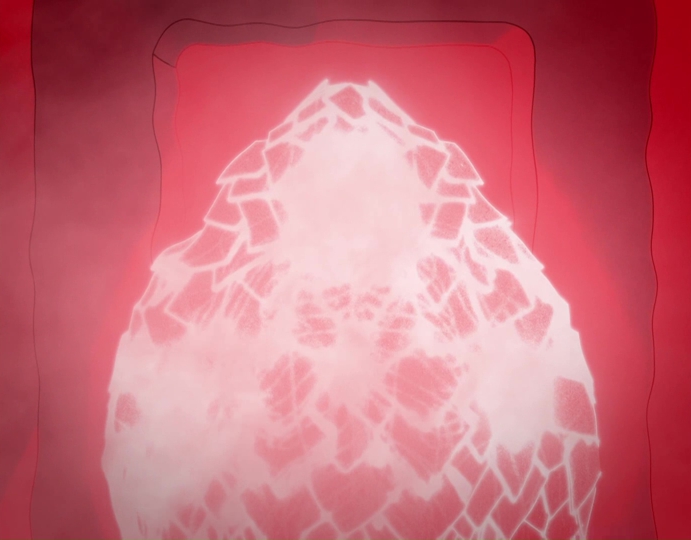
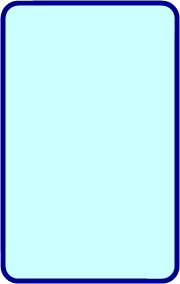
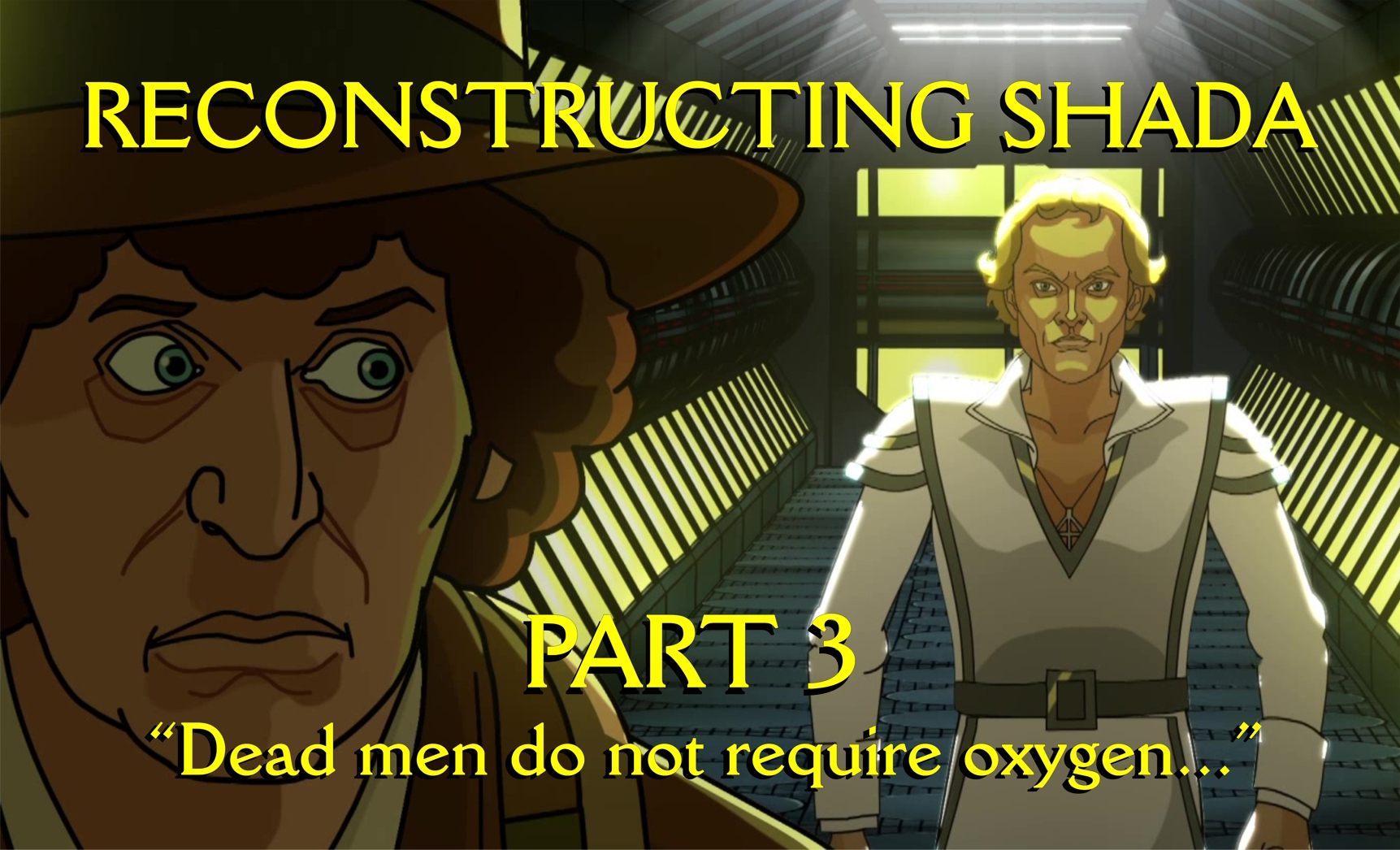
• CHARLES NORTON:
Skagra clicks his fingers a fair few times across this story. It's sort of what you do when you're a bit pompous and you want to attract someone's attention. Chris Neame actually did it live for us in the studio when he recorded his lines on 26th June 2017. However, he only did it once. So, every time you hear Skagra click his fingers, it's the same recording of the same click, just used and re-used over and over again.
Skagra clicks his fingers a fair few times across this story. It's sort of what you do when you're a bit pompous and you want to attract someone's attention. Chris Neame actually did it live for us in the studio when he recorded his lines on 26th June 2017. However, he only did it once. So, every time you hear Skagra click his fingers, it's the same recording of the same click, just used and re-used over and over again.

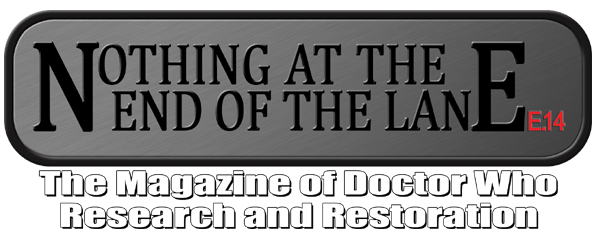
All timings in this article are taken from the 2017 master file for Shada. Whether you are watching the original 2017 DVD/BluRay; the 2021 Season 17 Blu-ray Collection box-set re-issue or the German-dubbed Polyband DVD/BluRay, the timings should still all match those cited here. It doesn't matter which edition you watch, as they should all use the same edit of the production. Of course, if you're watching the alternate 6-part special feature on the 2021 box-set or if you're watching the 1992 VHS compilation, then the timings won't match. So, if you are reading these viewing notes as you watch, make sure you're playing the right disc.
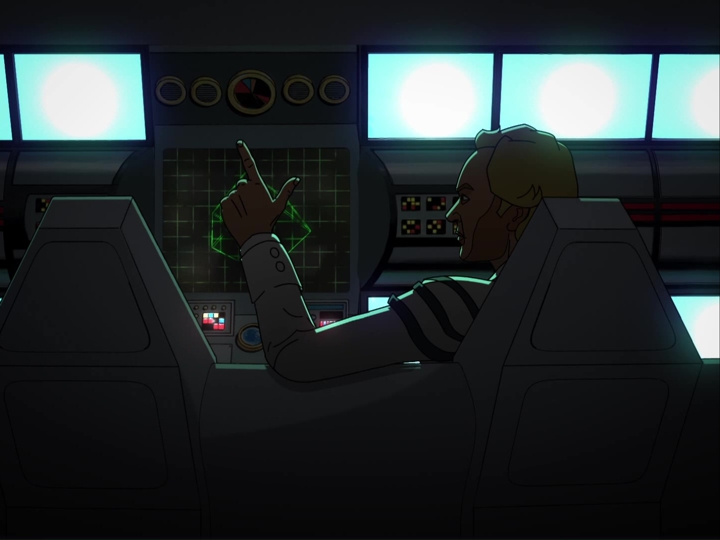
0:40:57 - Skagra clicks his fingers
0:41:05 - Skagra watches footage on his screen
• CHARLES NORTON:
All the material that you see displayed on Skagra's computer screen was completed back in 1979, as part of the original shoot. Some of it was shot specially, for the sole-purpose of being inlaid into this screen. Unfortunately, they never got around to shooting Skagra watching the images on the screen, only the screen images themselves. Consequently, in the final 2017 completion of this scene, you get a hybrid format, with an animated Skagra watching live-action footage. I did consider doing it entirely as an animation, but I actually quite liked how it looked mixing the two formats within one shot. It helps tie the whole thing together. As we cut between animation and live action (and back again) the blended shots help make the scene-junctures feel less jarring than they normally would.
All the material that you see displayed on Skagra's computer screen was completed back in 1979, as part of the original shoot. Some of it was shot specially, for the sole-purpose of being inlaid into this screen. Unfortunately, they never got around to shooting Skagra watching the images on the screen, only the screen images themselves. Consequently, in the final 2017 completion of this scene, you get a hybrid format, with an animated Skagra watching live-action footage. I did consider doing it entirely as an animation, but I actually quite liked how it looked mixing the two formats within one shot. It helps tie the whole thing together. As we cut between animation and live action (and back again) the blended shots help make the scene-junctures feel less jarring than they normally would.
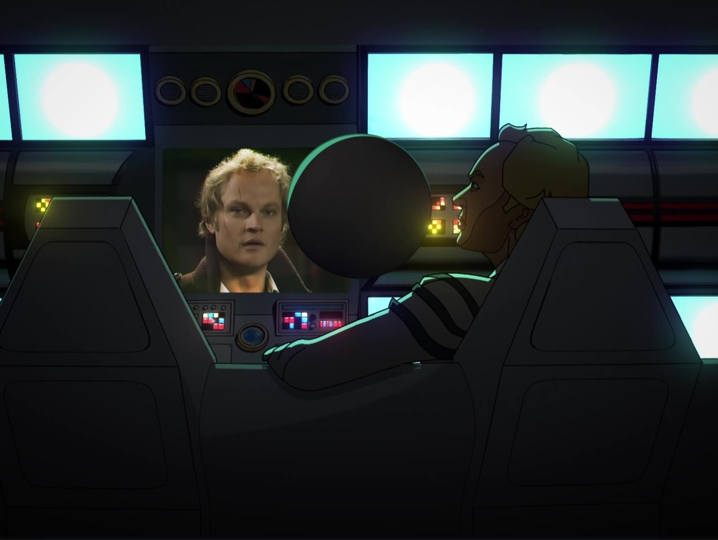
0:41:14 - Skagra in close-up
• ADRIAN SALMON:
Skagra is mostly hidden in deep shadow as he watches scenes unfold on a projector screen. I cast a deep purple shadow over his face which was edge-rimmed in an eerie green, adding a sinister aspect to the shot. Simple and effective.
Skagra is mostly hidden in deep shadow as he watches scenes unfold on a projector screen. I cast a deep purple shadow over his face which was edge-rimmed in an eerie green, adding a sinister aspect to the shot. Simple and effective.
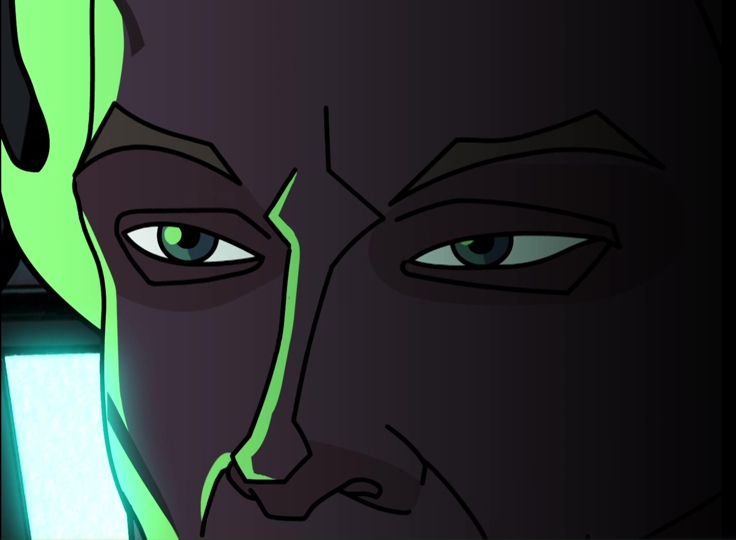
0:41:36 - Chris talks to Romana about the nature of science
• CHARLES NORTON:
The rather nice little monologue from Chris from 41'36" to 42'04" was trimmed out for the story's broadcast on BBC America. A cutaway of Chronotis (lifted from 41'54") was used to cover over the join in the edit. As before, this was all about getting the runtime down to make room for the commercials that BBC America had set aside for the programme's transmission slot. Interestingly, the original production team also decided they would make a cut here. The notes that were drawn up for a potential 1981 broadcast of Shada would also have seen them editing out Chris's little speech. They'd have cut everything from 41'36" to 42'03".
The rather nice little monologue from Chris from 41'36" to 42'04" was trimmed out for the story's broadcast on BBC America. A cutaway of Chronotis (lifted from 41'54") was used to cover over the join in the edit. As before, this was all about getting the runtime down to make room for the commercials that BBC America had set aside for the programme's transmission slot. Interestingly, the original production team also decided they would make a cut here. The notes that were drawn up for a potential 1981 broadcast of Shada would also have seen them editing out Chris's little speech. They'd have cut everything from 41'36" to 42'03".
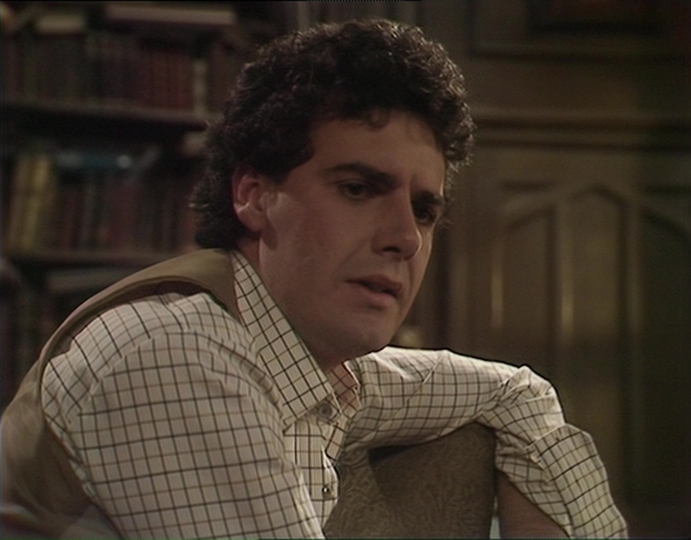
0:47:30 - The TARDIS dematerialises from the alley
• CHARLES NORTON:
After this scene, BBC America went to another commercial break. We rejoin the action (after the adverts) with Chris watching the vanishing professor.
After this scene, BBC America went to another commercial break. We rejoin the action (after the adverts) with Chris watching the vanishing professor.
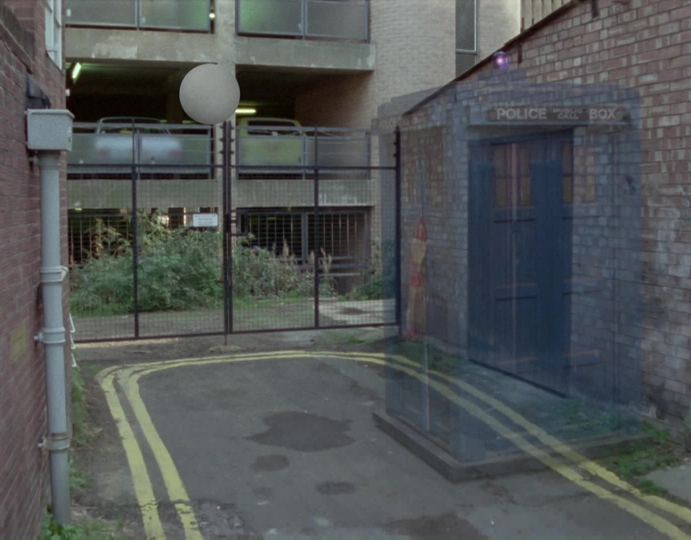
0:47:35 - The Doctor and Romana don't talk in the TARDIS
• CHARLES NORTON:
When Shada was originally written, there was another scene here. In between the TARDIS leaving the alley and it arriving back in the Professor's room, there was originally a short sequence set in the TARDIS, where the Doctor, K9 and Romana talk about Chronotis. In 1979, Pennant Roberts planned for this scene to open what would have been Part 3 of the originally projected six-part serialisation of the story. The same TARDIS scene would have appeared halfway through Part 2 of the later planned four-part serialisation of the story. There might possibly also have been a shorter scene after the TARDIS scene featuring Clare in the lab too. However, that latter scene is completely different in each of the three drafts of the scripts we had. So, we're less sure about that one.
Of course, when we finally completed Shada in 2017, none of this material appears anyway. We simply cut directly from the alley to the Professor's room, with no TARDIS scene in between at all. Apart from anything else this improves the pace somewhat. We're now carried along with the momentum of the TARDIS fleeing at speed from the alley and arriving (at equal speed) in the Professor's room. It feels all a bit more urgent and hurried, which increases the sense of danger. However, that wasn't our main motivation in doing it this way. The principal reason for the streamlining was again just to reduce the intercutting between live action and animation. That and us trying to keep to time too.
When Shada was originally written, there was another scene here. In between the TARDIS leaving the alley and it arriving back in the Professor's room, there was originally a short sequence set in the TARDIS, where the Doctor, K9 and Romana talk about Chronotis. In 1979, Pennant Roberts planned for this scene to open what would have been Part 3 of the originally projected six-part serialisation of the story. The same TARDIS scene would have appeared halfway through Part 2 of the later planned four-part serialisation of the story. There might possibly also have been a shorter scene after the TARDIS scene featuring Clare in the lab too. However, that latter scene is completely different in each of the three drafts of the scripts we had. So, we're less sure about that one.
Of course, when we finally completed Shada in 2017, none of this material appears anyway. We simply cut directly from the alley to the Professor's room, with no TARDIS scene in between at all. Apart from anything else this improves the pace somewhat. We're now carried along with the momentum of the TARDIS fleeing at speed from the alley and arriving (at equal speed) in the Professor's room. It feels all a bit more urgent and hurried, which increases the sense of danger. However, that wasn't our main motivation in doing it this way. The principal reason for the streamlining was again just to reduce the intercutting between live action and animation. That and us trying to keep to time too.
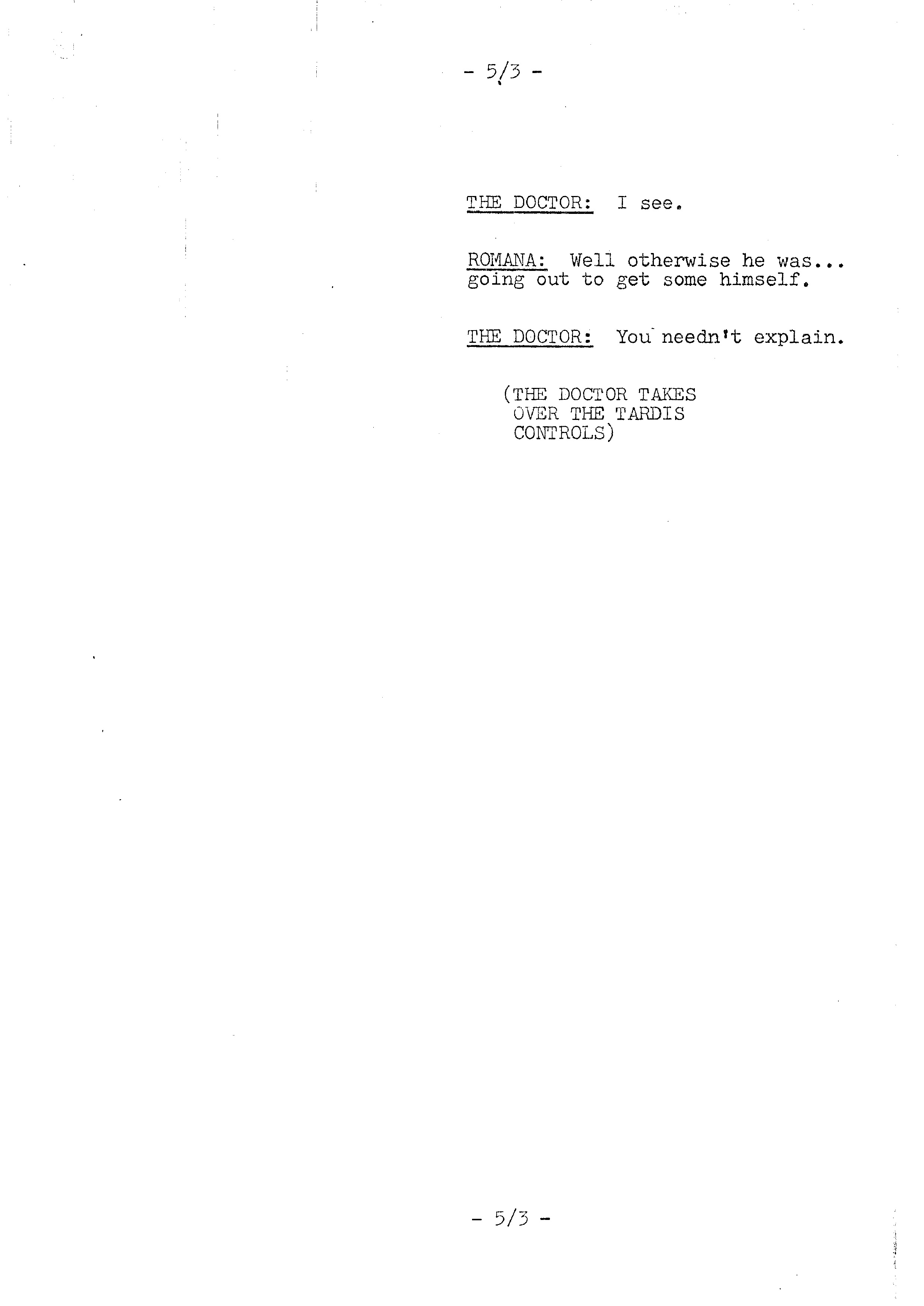
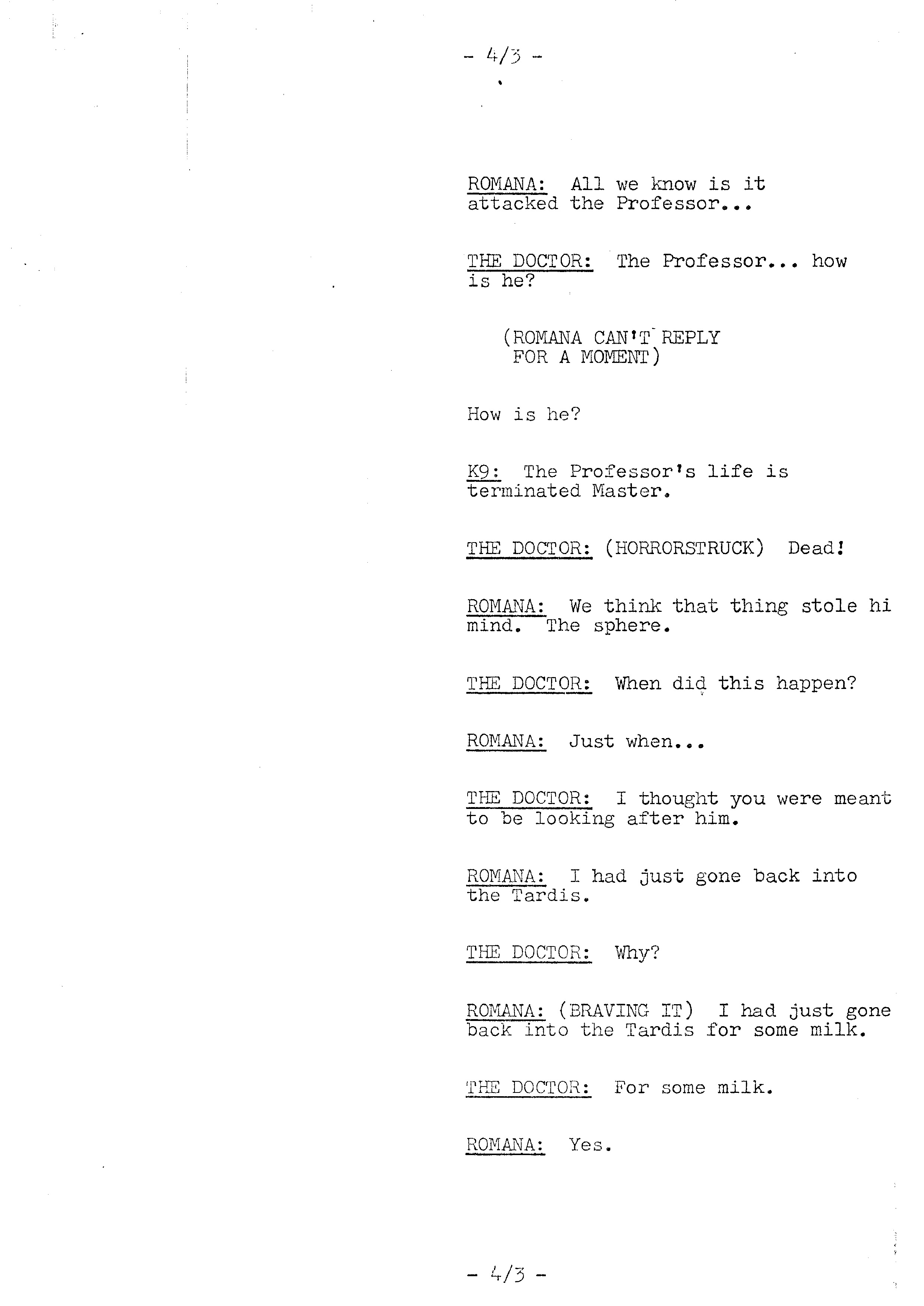
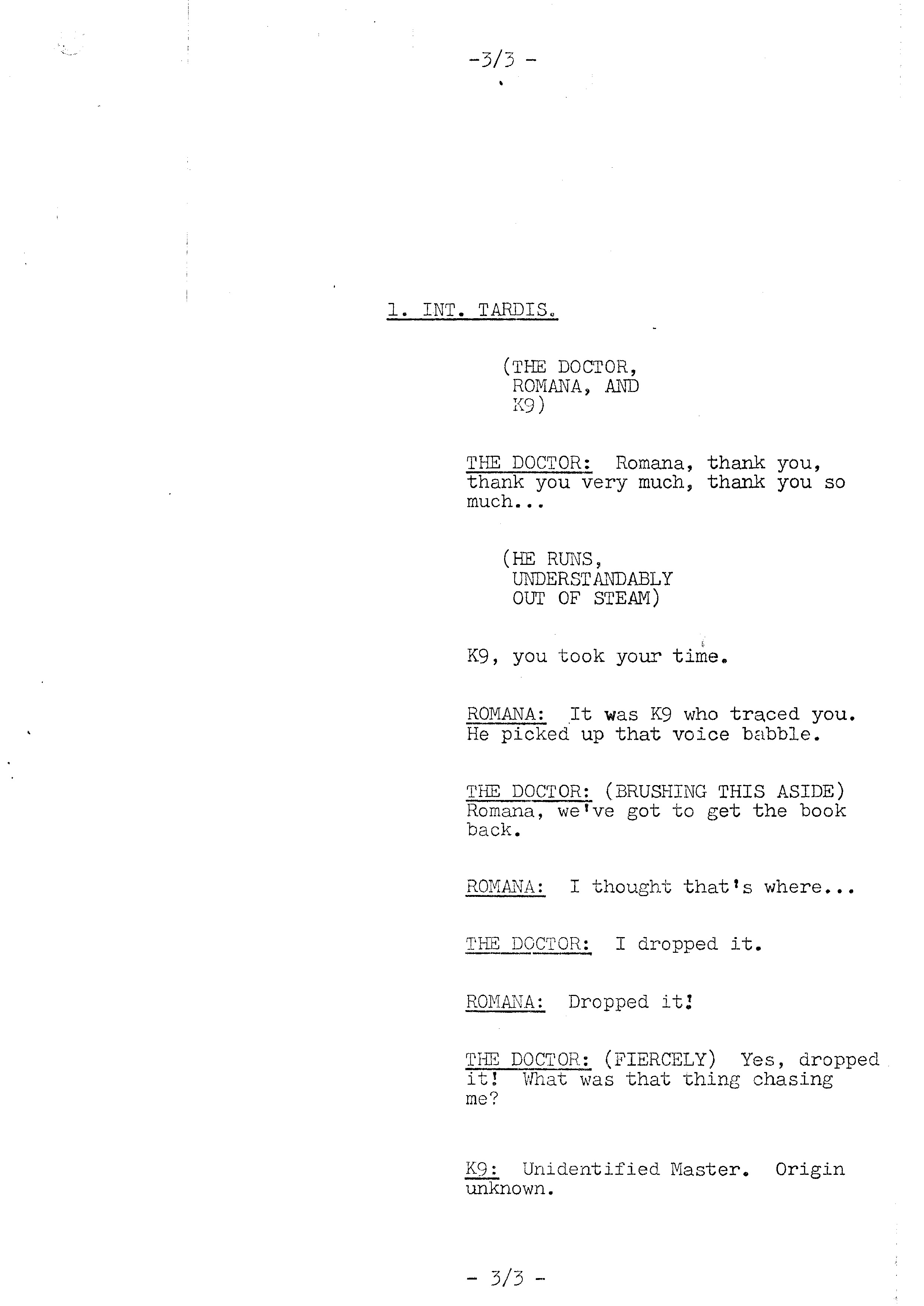
0:49:30 - Two lost scenes
• CHARLES NORTON:
If you take a look at the original 1979 scripts, you'll find two scenes at this point that didn't make it to our final cut in 2017. Not that we cut any actual footage, I hasten to add. We simply didn't record the material to begin with.
The first of the two cut scenes took place in the back alley in Cambridge. In this scene, the sphere is "moping around looking for the Doctor." It seems that it was Pennant Roberts' decision to delete this scene back in 1979. He either didn't film it or he filmed it and then decided to cut it. Either way, we couldn't find any film of the scene among the archived production materials - and we'd have expected to find it if it had been shot, as all the location filming on Shada was completed long before production shut down.
After the sphere-moping scene, the original rehearsal script next describes a scene in Chris Parson's lab, in which Clare finds Chris gone and leaves to search for him. Roberts didn't shoot this scene either. However, the paperwork suggest that he probably did intend to shoot it, but whether he'd have left it in his final edit or not, we obviously don't know. However, it was among the scenes lined up to be recorded at Television Centre in November 1979. When it came for us to look at the material in 2017 though, we decided to omit it. The only way we'd have been able to complete it would have been through animation. And that would have meant plonking a chunk of animation into a much longer stretch of live-action, which (as I've said) we avoided when we could. And as it was not vital to the narrative at this point, it actually helped the overall pacing of the drama to lose the material anyway.
If you take a look at the original 1979 scripts, you'll find two scenes at this point that didn't make it to our final cut in 2017. Not that we cut any actual footage, I hasten to add. We simply didn't record the material to begin with.
The first of the two cut scenes took place in the back alley in Cambridge. In this scene, the sphere is "moping around looking for the Doctor." It seems that it was Pennant Roberts' decision to delete this scene back in 1979. He either didn't film it or he filmed it and then decided to cut it. Either way, we couldn't find any film of the scene among the archived production materials - and we'd have expected to find it if it had been shot, as all the location filming on Shada was completed long before production shut down.
After the sphere-moping scene, the original rehearsal script next describes a scene in Chris Parson's lab, in which Clare finds Chris gone and leaves to search for him. Roberts didn't shoot this scene either. However, the paperwork suggest that he probably did intend to shoot it, but whether he'd have left it in his final edit or not, we obviously don't know. However, it was among the scenes lined up to be recorded at Television Centre in November 1979. When it came for us to look at the material in 2017 though, we decided to omit it. The only way we'd have been able to complete it would have been through animation. And that would have meant plonking a chunk of animation into a much longer stretch of live-action, which (as I've said) we avoided when we could. And as it was not vital to the narrative at this point, it actually helped the overall pacing of the drama to lose the material anyway.
0:49:30: - A fisherman is attacked by the sphere
• CHARLES NORTON:
This scene was not included in the BBC America transmission in 2018. As before, it was cut for timing reasons. Strangely however, the scene is also not in any of the original 1979 scripts either. It appears to have been something Pennant Roberts made up at very short notice during the location shoot. It replaces a completely different scene in Douglas Adams' original script where a man is attacked on a bicycle. I suppose that (in theory) we could have scrapped Roberts' replacement scene and tried to create an animation of Douglas Adams' originally scripted scene. However, we didn't really want to. I like Roberts' new scene. It's more dramatic. Not least of all because he gives the stuntman more to do.
• RICHARD BIGNELL:
Evidently, Pennant Roberts had given some forethought to this particular scene. The production's costume and make-up paperwork shows that James Muir had been cast in the role of the fisherman for this particuar sequence at least two weeks before the location filming began. Perhaps Roberts felt that the story already had a surfeit of bicycle scenes and it would be nice to show something different?
This scene was not included in the BBC America transmission in 2018. As before, it was cut for timing reasons. Strangely however, the scene is also not in any of the original 1979 scripts either. It appears to have been something Pennant Roberts made up at very short notice during the location shoot. It replaces a completely different scene in Douglas Adams' original script where a man is attacked on a bicycle. I suppose that (in theory) we could have scrapped Roberts' replacement scene and tried to create an animation of Douglas Adams' originally scripted scene. However, we didn't really want to. I like Roberts' new scene. It's more dramatic. Not least of all because he gives the stuntman more to do.
• RICHARD BIGNELL:
Evidently, Pennant Roberts had given some forethought to this particular scene. The production's costume and make-up paperwork shows that James Muir had been cast in the role of the fisherman for this particuar sequence at least two weeks before the location filming began. Perhaps Roberts felt that the story already had a surfeit of bicycle scenes and it would be nice to show something different?
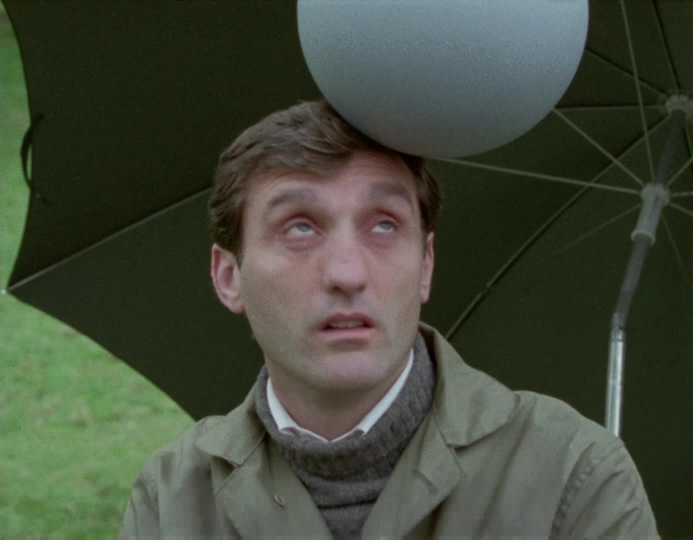
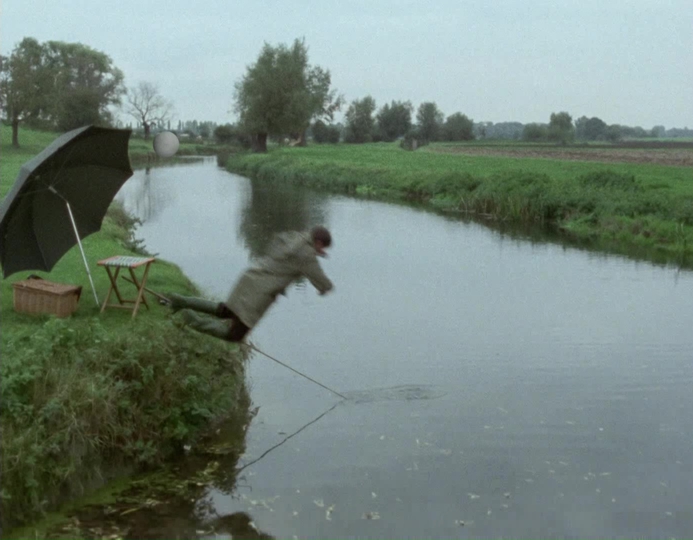
0:50:23 - The Doctor doesn't talk to K9
• CHARLES NORTON:
Another (very brief) deviation from the original script here. Pennant Roberts had planned to have a scene in the TARDIS at this point (just after the man's fall into the river and just before we join Clare). The scene would have featured a brief exchange between the Doctor and K9. However, without David Brierley, there was no way for us to complete the scene satisfactorily, or at least, not as originally envisioned. Consequently, we decided not to record it and simply jump to the next scene. To be honest, even without the factor of David's death, I suspect that we may have ended up cutting this scene anyway. It adds nothing substantial to the narrative and an animated scene at this point (of such brevity) could have pulled us out of the story.
Another (very brief) deviation from the original script here. Pennant Roberts had planned to have a scene in the TARDIS at this point (just after the man's fall into the river and just before we join Clare). The scene would have featured a brief exchange between the Doctor and K9. However, without David Brierley, there was no way for us to complete the scene satisfactorily, or at least, not as originally envisioned. Consequently, we decided not to record it and simply jump to the next scene. To be honest, even without the factor of David's death, I suspect that we may have ended up cutting this scene anyway. It adds nothing substantial to the narrative and an animated scene at this point (of such brevity) could have pulled us out of the story.
0:51:32 - Skagra examines the book
• CHARLES NORTON:
Chris Bowles did the animation on Skagra for this scene. Chris first worked with us on a Dad's Army animation we made in 2015 for BBC Store. He'd briefly been attached to work on The Power of the Daleks the following year, but had to back out at the last minute. So Shada marked his first time on Doctor Who. He would later be one of our team of character animators on The Macra Terror in 2018 - making him the only animator to have worked on all three of those animations.
I like the way that we were able to use the live action footage again in this scene. It better beds the animation in with the surrounding location filming. In the 1979 rehearsal script, the material contained in this scene was originally split across two short scenes, intercutting more with the events outside. To help the transitions between animation and live action seem less choppy, we gathered all the material from both scenes together into one long scene.
Chris Bowles did the animation on Skagra for this scene. Chris first worked with us on a Dad's Army animation we made in 2015 for BBC Store. He'd briefly been attached to work on The Power of the Daleks the following year, but had to back out at the last minute. So Shada marked his first time on Doctor Who. He would later be one of our team of character animators on The Macra Terror in 2018 - making him the only animator to have worked on all three of those animations.
I like the way that we were able to use the live action footage again in this scene. It better beds the animation in with the surrounding location filming. In the 1979 rehearsal script, the material contained in this scene was originally split across two short scenes, intercutting more with the events outside. To help the transitions between animation and live action seem less choppy, we gathered all the material from both scenes together into one long scene.
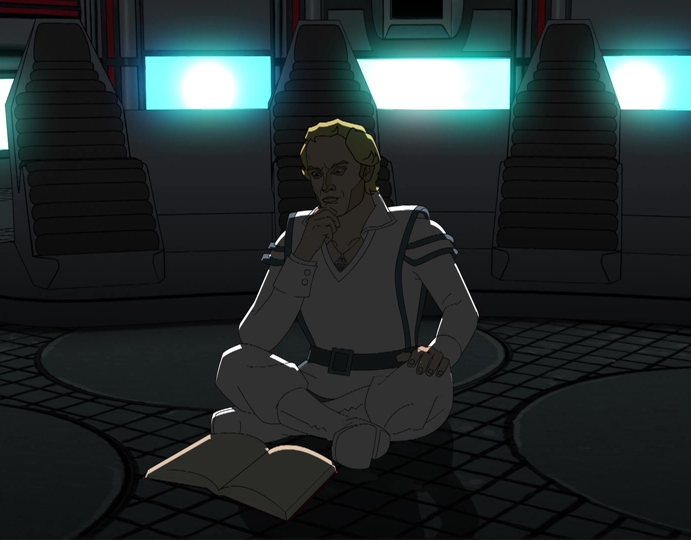
0:54:20 - The Doctor, Chris, Romana and K9 ascend into the ship
• CHARLES NORTON:
Another of those 'missing' shots for which we briefly lost access to the negatives. This one was an exceptionally tricky one to grade. The colour balance varies so dramatically across the shots, due to the changing weather and the fact that the inserts were, unusually, all filmed many days later on a blue screen stage at Ealing - the first (and only) time that Doctor Who attempted to shoot blue-screen work on film in the original series.
In fact, at the time of writing, I think the grading on this scene is one of the things that Peter Crocker (who handled all the film remastering on Shada) is hoping to tweak a bit for the 2021 Season 17 Collection Blu-ray re-issue. So, by the time you read this, any inconsistencies in light levels may already have been ironed out.
• MARK AYRES:
Actually, the 2021 re-grade gave us all nightmares. It’s still not perfect…but…
• CHARLES NORTON:
For those keeping track of the story's broadcast on BBC America in 2018, it is after this scene (at 54'40") that BBC America inserted their next ad break.
Another of those 'missing' shots for which we briefly lost access to the negatives. This one was an exceptionally tricky one to grade. The colour balance varies so dramatically across the shots, due to the changing weather and the fact that the inserts were, unusually, all filmed many days later on a blue screen stage at Ealing - the first (and only) time that Doctor Who attempted to shoot blue-screen work on film in the original series.
In fact, at the time of writing, I think the grading on this scene is one of the things that Peter Crocker (who handled all the film remastering on Shada) is hoping to tweak a bit for the 2021 Season 17 Collection Blu-ray re-issue. So, by the time you read this, any inconsistencies in light levels may already have been ironed out.
• MARK AYRES:
Actually, the 2021 re-grade gave us all nightmares. It’s still not perfect…but…
• CHARLES NORTON:
For those keeping track of the story's broadcast on BBC America in 2018, it is after this scene (at 54'40") that BBC America inserted their next ad break.
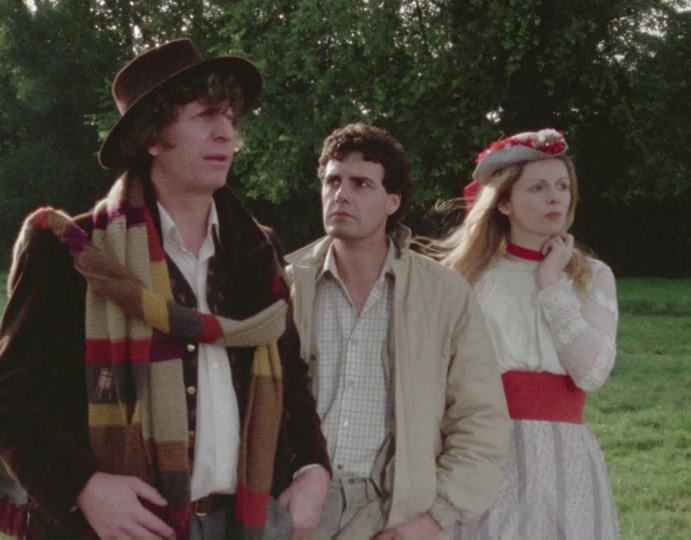
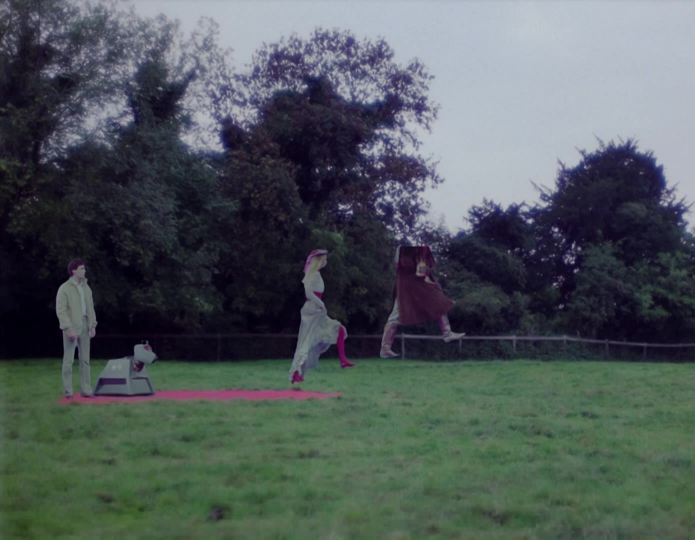
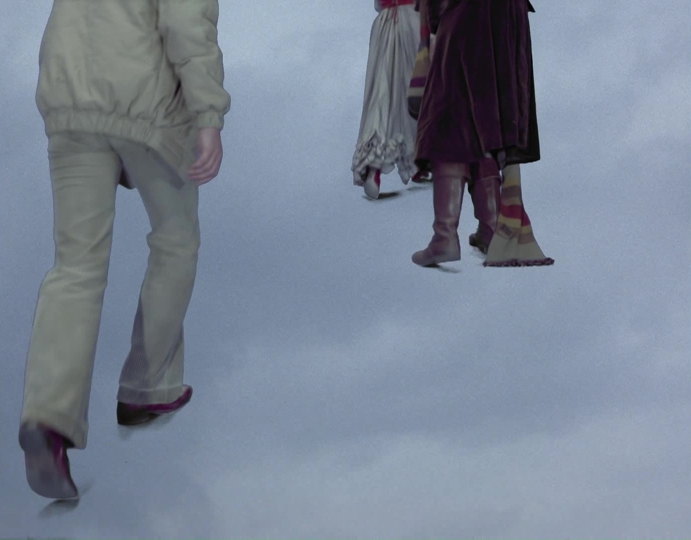
0:54:40 - Clare searches for Chris
• CHARLES NORTON:
I slightly re-ordered the scenes here. In the final edit, you get the scene of Clare searching for Chris in the Professor's room and then you get the scene of Chris, Romana and the Doctor walking down the corridor in the ship. In the original 1979 rehearsal and camera scripts, the two scenes are actually the other way around. So you get the spaceship scene and then the scene in the Professor's room. Why swap the running order? Well, again, it's to avoid too much inter-cutting between live-action and animation.
I slightly re-ordered the scenes here. In the final edit, you get the scene of Clare searching for Chris in the Professor's room and then you get the scene of Chris, Romana and the Doctor walking down the corridor in the ship. In the original 1979 rehearsal and camera scripts, the two scenes are actually the other way around. So you get the spaceship scene and then the scene in the Professor's room. Why swap the running order? Well, again, it's to avoid too much inter-cutting between live-action and animation.
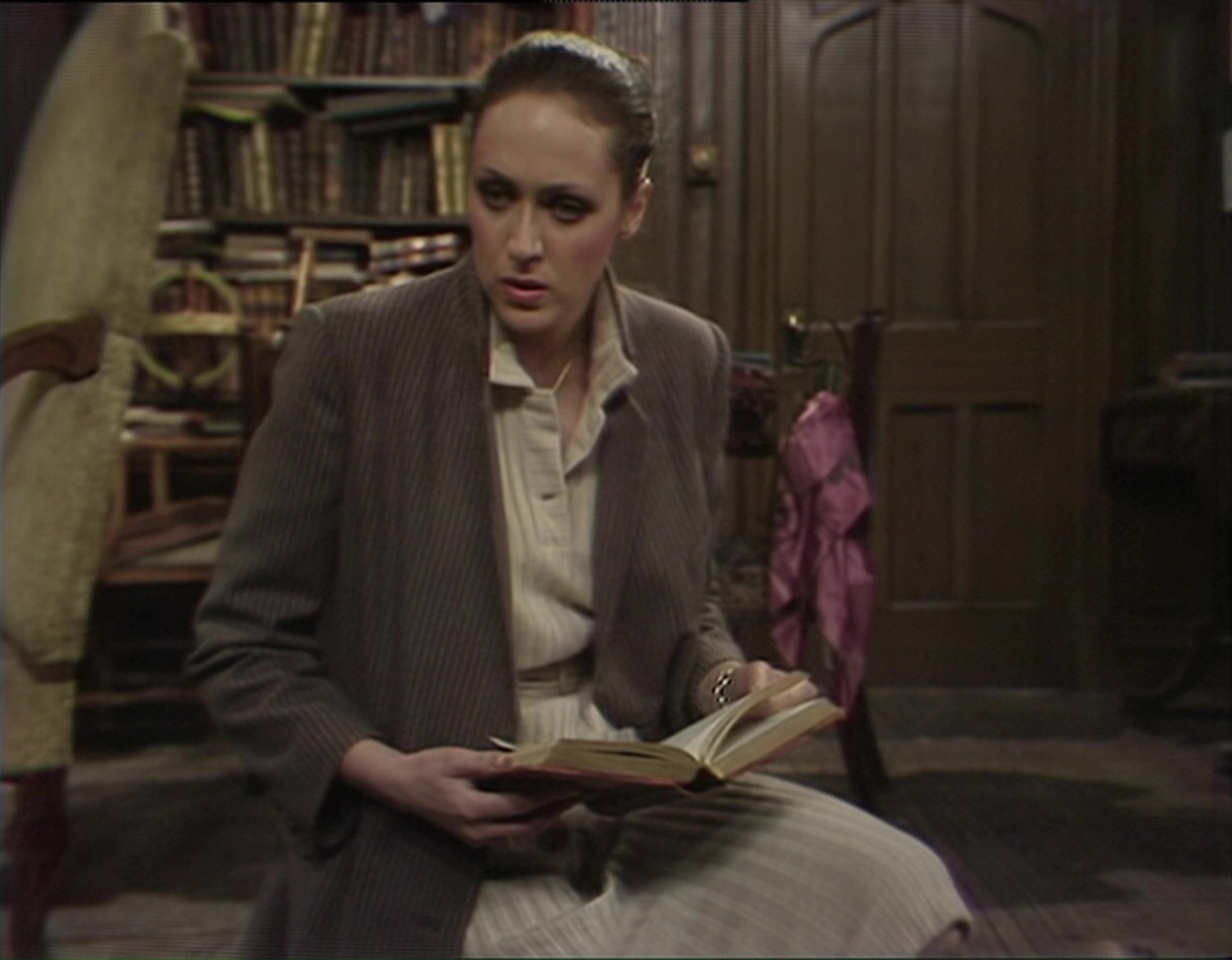
0:55:25 - K9 talks to the Doctor
• CHARLES NORTON:
K9 was originally scripted to have three lines of dialogue in this scene. The first of those lines is: "Master?" The second is again: "Master?" And the final line is: "All signal sources are confused, Master." Of course, this scene was never shot back in 1979 and consequently, David Brierley never had a chance to record any of those lines. However, due to the simplicity of K9's dialogue, we were able to find a solution to this problem.
Among the thousands of recordings in the BBC Radiophonic Workshop Archive, Mark Ayres found a tape of K9 dialogue that was very useful to us on Shada. The tape was essentially a tape of stock K9 lines. Generic stuff really. "Yes, Master," "No, Master," 'Danger, Master," "Insufficient data." Things like that. It had been recorded by David Brierley in a studio session many years ago. And because it was recorded in a sound studio, rather than a TV studio, all the audio was extremely clean and easy to dub into whatever scene we needed to. We used this tape a lot, when making Shada. Pretty much, whenever K9 needed to speak, we sourced the audio from this tape. It was invaluable. It did have one major drawback, however. K9 could only ever say something if we actually had it on this tape. And although the tape covered most of K9's more obvious stock phrases, it didn't cover everything.
Therefore, whenever I came to a scene like this one on the ship, I had to either rework the script, to get K9 to say something we had a recording of or alternatively, I had to get another character to say something that would remove the need for K9 to talk at all. In the case of this particular scene, we did quite well and managed to get everything across with relatively little modification. For K9's final line, I gave the Doctor's scripted dialogue to Romana instead, removing the need for K9 to speak to the Doctor. We then had K9 reply to a new question from Romana with the line: "Negative, Mistress." Which was one of the stock phrases on our tape. The final audio isn't quite what was originally intended, of course. However, it still makes sense and it keeps David Brierley's K9 in the scene, just as he would have been had the scene actually been shot as planned back in 1979.
K9 was originally scripted to have three lines of dialogue in this scene. The first of those lines is: "Master?" The second is again: "Master?" And the final line is: "All signal sources are confused, Master." Of course, this scene was never shot back in 1979 and consequently, David Brierley never had a chance to record any of those lines. However, due to the simplicity of K9's dialogue, we were able to find a solution to this problem.
Among the thousands of recordings in the BBC Radiophonic Workshop Archive, Mark Ayres found a tape of K9 dialogue that was very useful to us on Shada. The tape was essentially a tape of stock K9 lines. Generic stuff really. "Yes, Master," "No, Master," 'Danger, Master," "Insufficient data." Things like that. It had been recorded by David Brierley in a studio session many years ago. And because it was recorded in a sound studio, rather than a TV studio, all the audio was extremely clean and easy to dub into whatever scene we needed to. We used this tape a lot, when making Shada. Pretty much, whenever K9 needed to speak, we sourced the audio from this tape. It was invaluable. It did have one major drawback, however. K9 could only ever say something if we actually had it on this tape. And although the tape covered most of K9's more obvious stock phrases, it didn't cover everything.
Therefore, whenever I came to a scene like this one on the ship, I had to either rework the script, to get K9 to say something we had a recording of or alternatively, I had to get another character to say something that would remove the need for K9 to talk at all. In the case of this particular scene, we did quite well and managed to get everything across with relatively little modification. For K9's final line, I gave the Doctor's scripted dialogue to Romana instead, removing the need for K9 to speak to the Doctor. We then had K9 reply to a new question from Romana with the line: "Negative, Mistress." Which was one of the stock phrases on our tape. The final audio isn't quite what was originally intended, of course. However, it still makes sense and it keeps David Brierley's K9 in the scene, just as he would have been had the scene actually been shot as planned back in 1979.
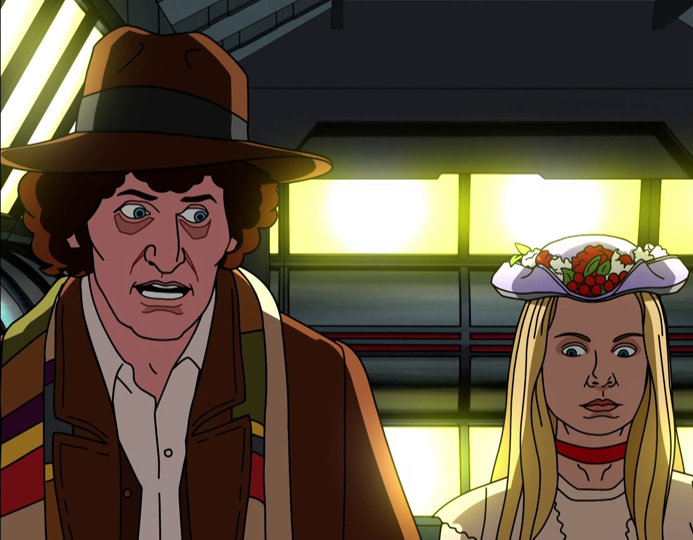
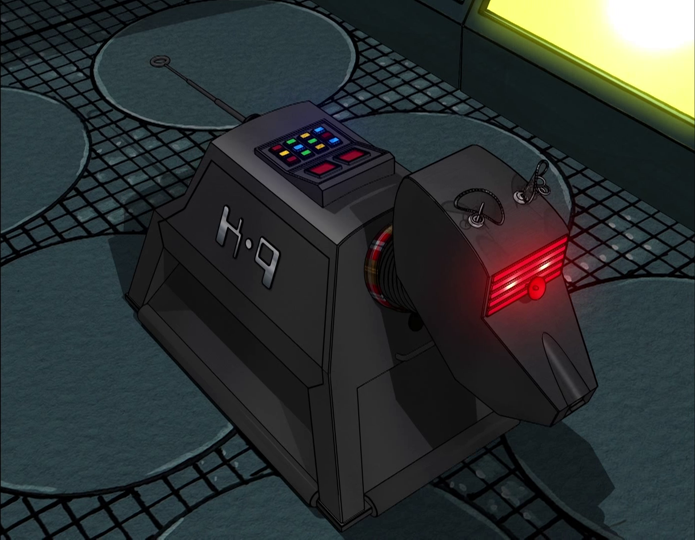
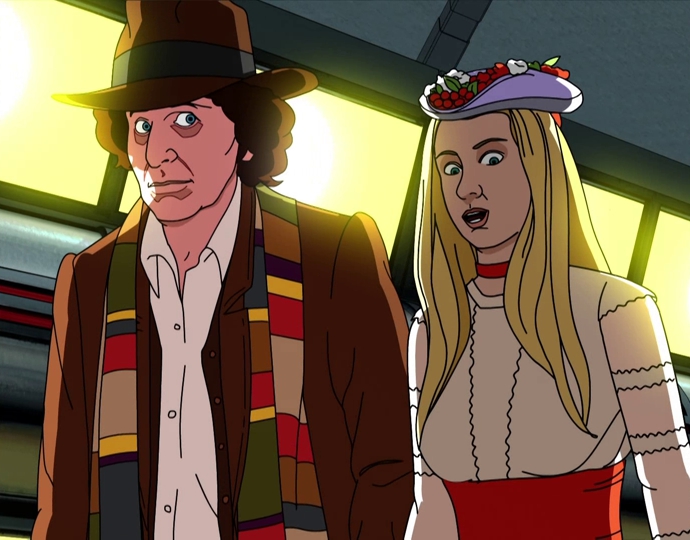
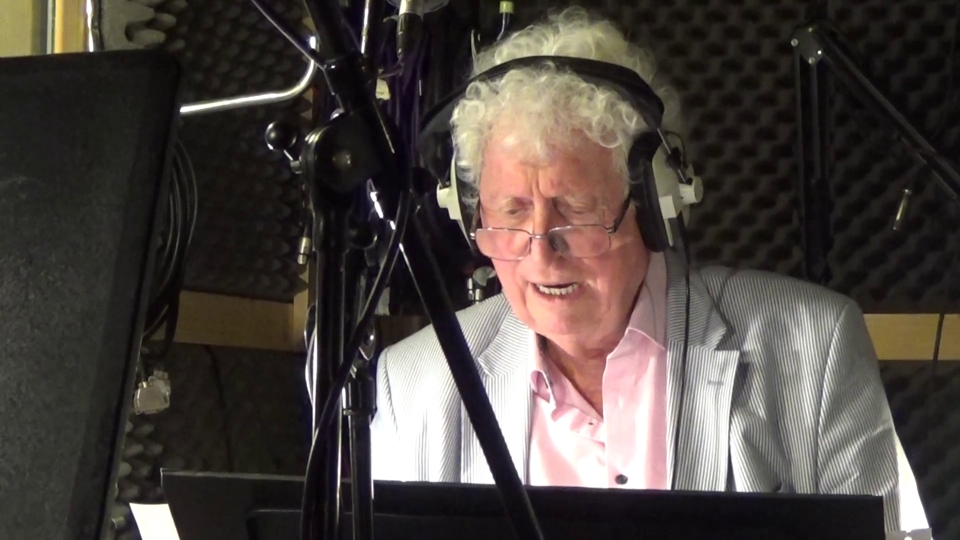
The rest of the dialogue in the scene (from the Doctor, Chris and Romana) was recorded in studio sessions on 9th June and 26th June 2017. We used a stand-in for K9 on the actual recording day and only dropped the final David Brierley tracks into the mix at the editing stage. Our K9 stand-in was Toby Hadoke, who would read all K9's lines in off-mic from a corner of the room, while Tom and Daniel delivered their lines to mic as normal. Toby made a really excellent K9. In fact, he was so good that when John Kelly was editing the animatic together for us, he didn't realise it was Toby's K9 he was listening to and assumed we'd just played the Brierley audio live into the studio.
Tom Baker at Audio Sorcery Studios, 9th June 2017 (Image © Charles Norton)
0:55:50 - Skagra confronts the Doctor
• CHARLES NORTON:
Another very long animated take here – and deliberately so. The blocking was actually very difficult to achieve with 2D animation and I'm not sure if I'd attempt something quite so fiendishly complex if I were to do this again now. As Skagra walks in and out of each pool of light, the light has to be frame-by-frame animated moving over his head and face. It took an awfully long time to do with Adrian Salmon and David Busch handling the bulk of the light work, while the character animation underneath was done by Barry Evans.
• ADRIAN SALMON:
We devised a technically complicated scene for Skagra’s long walk down the ship’s corridor. He would walk in and out of pools of light as he came towards us. This required a number of key frames to be shaded first, becoming bigger and more detailed as he advanced. One set of him in shadow, the other in the light which were given to animator David Busch to use as the basis of the animated walk.
• CHARLES NORTON:
When you watch this scene in the original 2017 release, you might just about notice that the perspective is slightly off on the characters, by the way. If you get a ruler out, you'll see that the vanishing points end up drifting and the characters are in the wrong relative positions to each other. It's an amazingly subtle error. However, at the time of writing this, I'm hoping that we can maybe fix it for the 2021 reissue.
Another very long animated take here – and deliberately so. The blocking was actually very difficult to achieve with 2D animation and I'm not sure if I'd attempt something quite so fiendishly complex if I were to do this again now. As Skagra walks in and out of each pool of light, the light has to be frame-by-frame animated moving over his head and face. It took an awfully long time to do with Adrian Salmon and David Busch handling the bulk of the light work, while the character animation underneath was done by Barry Evans.
• ADRIAN SALMON:
We devised a technically complicated scene for Skagra’s long walk down the ship’s corridor. He would walk in and out of pools of light as he came towards us. This required a number of key frames to be shaded first, becoming bigger and more detailed as he advanced. One set of him in shadow, the other in the light which were given to animator David Busch to use as the basis of the animated walk.
• CHARLES NORTON:
When you watch this scene in the original 2017 release, you might just about notice that the perspective is slightly off on the characters, by the way. If you get a ruler out, you'll see that the vanishing points end up drifting and the characters are in the wrong relative positions to each other. It's an amazingly subtle error. However, at the time of writing this, I'm hoping that we can maybe fix it for the 2021 reissue.
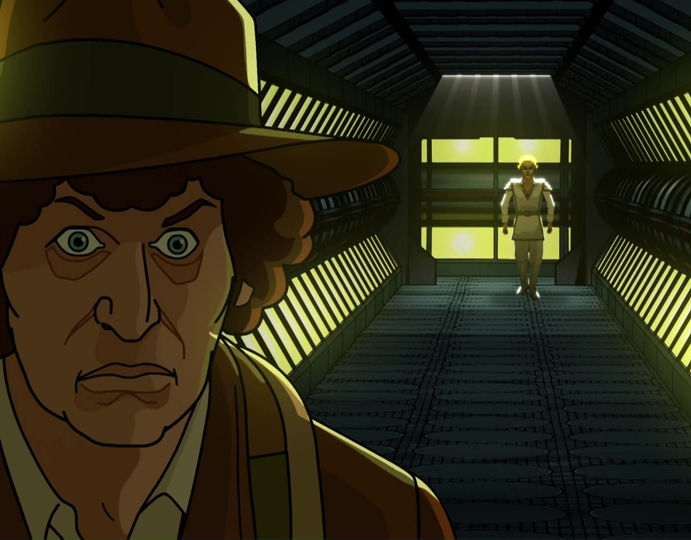
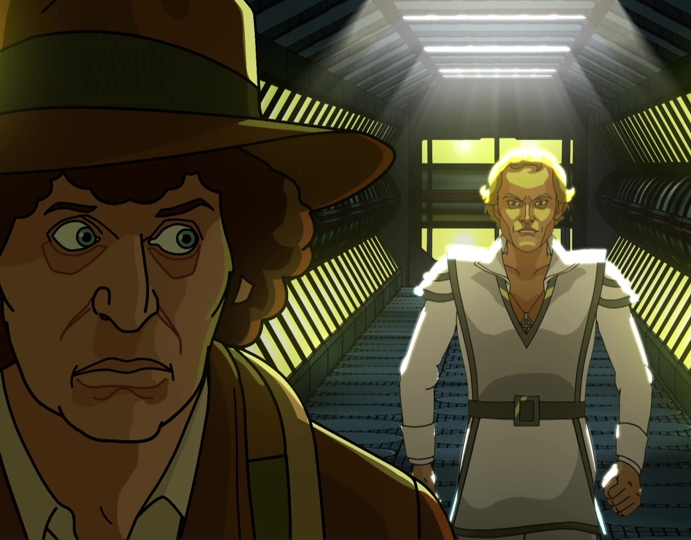
0:56:20 - Skagra talks to the Doctor
• CHARLES NORTON:
The character work for this entire scene was animated by Robin Brindle (who first worked with us on The Power of the Daleks). He did a superb job, aided by some excellent shading key-frames from Adrian Salmon. Sadly however, the scene was slightly undermined by a faulty frame-rate interpolation plug-in that we used in the render. It gives the lip-sync a slightly rubbery quality, like everyone is chewing on toffee. It's most noticeable on the Doctor, as the rendering algorithm can't quite make sense of how Tom's teeth are supposed to work. Happily, (at the time of writing) it's something we are fixing for the 2021 re-release. The animation itself is fine, it's just the frame rate that's a bit weird for a few moments. It affects a few other scenes too (all of which we're fixing). However, it's most noticeable here.
The character work for this entire scene was animated by Robin Brindle (who first worked with us on The Power of the Daleks). He did a superb job, aided by some excellent shading key-frames from Adrian Salmon. Sadly however, the scene was slightly undermined by a faulty frame-rate interpolation plug-in that we used in the render. It gives the lip-sync a slightly rubbery quality, like everyone is chewing on toffee. It's most noticeable on the Doctor, as the rendering algorithm can't quite make sense of how Tom's teeth are supposed to work. Happily, (at the time of writing) it's something we are fixing for the 2021 re-release. The animation itself is fine, it's just the frame rate that's a bit weird for a few moments. It affects a few other scenes too (all of which we're fixing). However, it's most noticeable here.
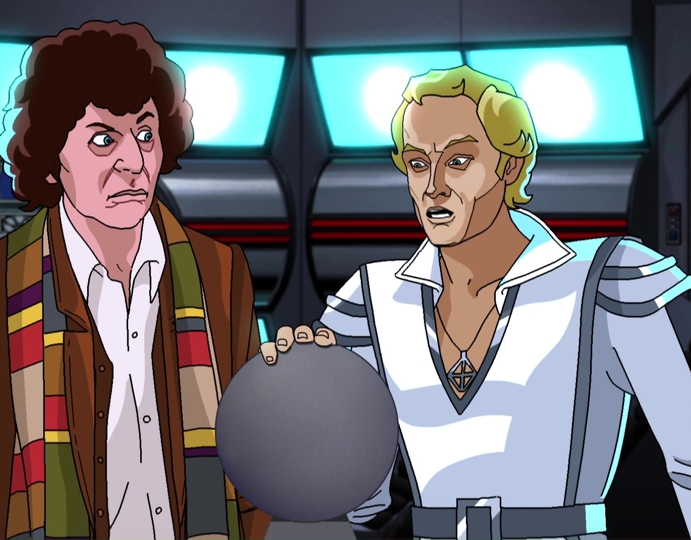
0:57:00 - Skagra talks to the Doctor Part 2
• CHARLES NORTON:
In the final edit, Skagra tells the Doctor: "We have more important matters to discuss. This book, Doctor..." And that whole speech is covered by a single continuous shot. However, in the original rehearsal script, things are a little bit different. In the script, this scene is actually split in two, with another scene cut into the middle. There, Skagra says: "We have more important matters to discuss." And then the scene ends. We then cut to a scene at Cambridge University with Clare talking to the porter. We then cut back to the ship, for Skagra's line of: "This book, Doctor..."
In our edit, we've moved the scene with Clare and the porter so that it comes a lot later on in the story and we've run the two Skagra scenes together into one long scene. Again, this was done to reduce the inter-cutting between live-action and animation. However, if you look carefully at the rehearsal script notations, it is perhaps worth saying that, although we've altered things a bit, our scene-merging doesn't run entirely counter to the original intention for this material either. The first Skagra scene is marked down as scene 3.10 and the second Skagra scene is marked down as scene 3.10a. What this means is that the two scenes were almost certainly originally scripted by Douglas Adams as one long scene anyway. The decision to split the scene into two, by cutting away to Cambridge, was probably made quite late in the day, possibly by Pennant Roberts. It was obviously done to increase the pace of this section of the story and, for what it's worth, it is successful in doing this. However, I also quite like the intensity of staying with the Doctor and Skagra in their big stand-off, which is very well written (as are all of the exchanges between the Doctor and Skagra). So, although we've again felt forced to do some surgery on the edit at this point, it's interesting that in the process of doing it, we've may unintentionally have also restored the scene back to how Douglas Adams originally envisioned it. Maybe.
In the final edit, Skagra tells the Doctor: "We have more important matters to discuss. This book, Doctor..." And that whole speech is covered by a single continuous shot. However, in the original rehearsal script, things are a little bit different. In the script, this scene is actually split in two, with another scene cut into the middle. There, Skagra says: "We have more important matters to discuss." And then the scene ends. We then cut to a scene at Cambridge University with Clare talking to the porter. We then cut back to the ship, for Skagra's line of: "This book, Doctor..."
In our edit, we've moved the scene with Clare and the porter so that it comes a lot later on in the story and we've run the two Skagra scenes together into one long scene. Again, this was done to reduce the inter-cutting between live-action and animation. However, if you look carefully at the rehearsal script notations, it is perhaps worth saying that, although we've altered things a bit, our scene-merging doesn't run entirely counter to the original intention for this material either. The first Skagra scene is marked down as scene 3.10 and the second Skagra scene is marked down as scene 3.10a. What this means is that the two scenes were almost certainly originally scripted by Douglas Adams as one long scene anyway. The decision to split the scene into two, by cutting away to Cambridge, was probably made quite late in the day, possibly by Pennant Roberts. It was obviously done to increase the pace of this section of the story and, for what it's worth, it is successful in doing this. However, I also quite like the intensity of staying with the Doctor and Skagra in their big stand-off, which is very well written (as are all of the exchanges between the Doctor and Skagra). So, although we've again felt forced to do some surgery on the edit at this point, it's interesting that in the process of doing it, we've may unintentionally have also restored the scene back to how Douglas Adams originally envisioned it. Maybe.
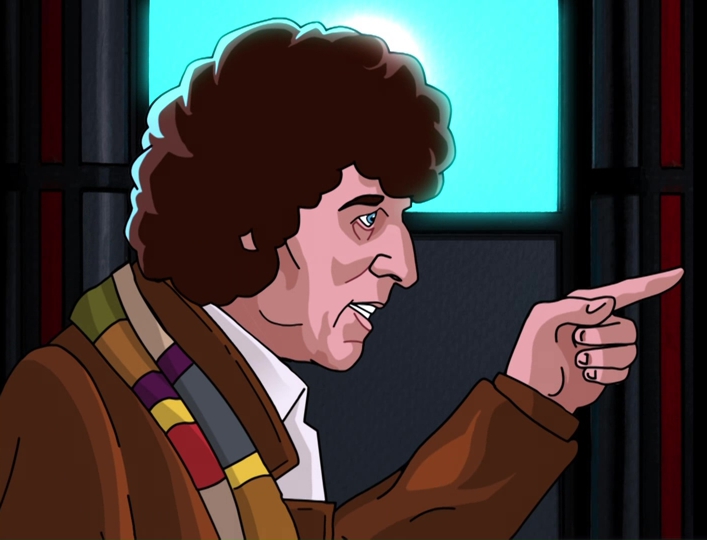
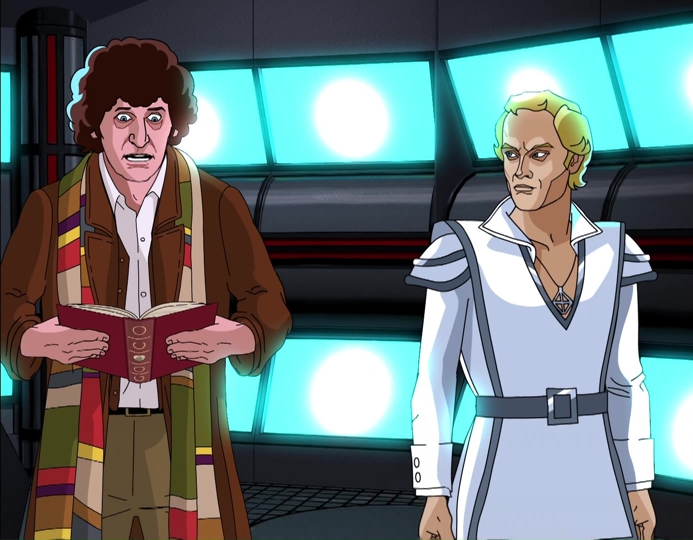
0:57:37 - The Doctor reads from the book
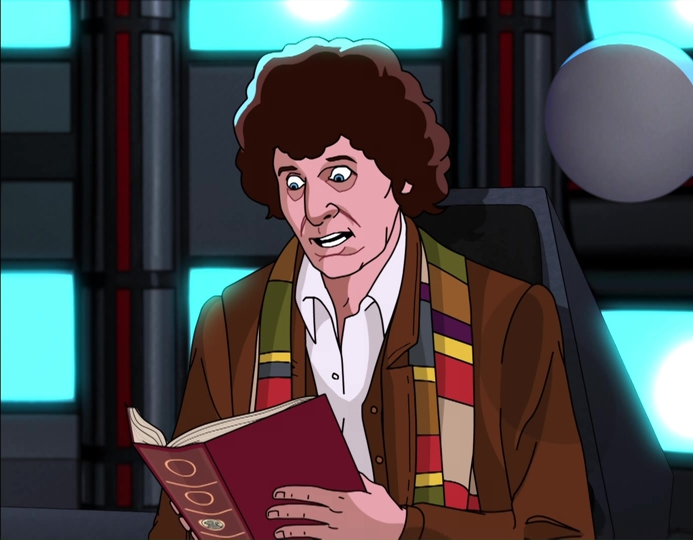
• CHARLES NORTON:
When the he reads the coded text in the book, Douglas Adams had scripted for the Doctor to say: "Grrrr vdd thrrrr hurhurgh dud dududud vvvllll... jjjjdddrrr gr gr gr hummmmm." And as those keys aren't always all that close together on a qwerty keyboard, it actually looks like Adams put some genuine thought into that. The carefully honed gibberish even looks rather good on the page. However, it is, of course, also completely impossible to say.
When it came to us recording the scene proper (during our first studio day on 9th June 2017), I asked Tom simply to come up with some suitable sounding gibberish of his own invention for the coded text. And that's basically what he did. However, there was also rather a lot more to it than just gibberish.
Tom told us of how, as a child growing up in Liverpool, he recalled that they sometimes picked news broadcasts from the Welsh language service of the BBC. And as a child, who understood no Welsh at all, it always sounded rather odd to him. He remembered that the news always seemed to be read by a man called Hywel Davies. The name stuck with him, as it was the only bit of the broadcast he could clearly make out, as the newsreader signed off at the end of each bulletin. The rest was just a string of unintelligible sounds to young Tom, with this single distinct name popping up in the middle of an otherwise entirely Welsh sentence.
Flash forward to 2017 and Tom came to the studio that morning with an idea for the code-text scene. And that's what you get in the finished programme - Tom Baker reciting a childhood memory of what a man called Hywel Davies sounded like when reading the news in Welsh. Complete with the mid sentence name-drop for Hywel Davies himself.
NOTE: Hywel Davies OBE worked for the BBC from 1942 to 1965. He was a key figure in Welsh regional broadcasting, both on radio and television. In charge of the BBC's Welsh language news service throughout the 50s and 60s, he soon became a very familiar voice to post-war audiences across the UK, both as a news broadcaster and an interviewer. He died on 16th October 1965.
When the he reads the coded text in the book, Douglas Adams had scripted for the Doctor to say: "Grrrr vdd thrrrr hurhurgh dud dududud vvvllll... jjjjdddrrr gr gr gr hummmmm." And as those keys aren't always all that close together on a qwerty keyboard, it actually looks like Adams put some genuine thought into that. The carefully honed gibberish even looks rather good on the page. However, it is, of course, also completely impossible to say.
When it came to us recording the scene proper (during our first studio day on 9th June 2017), I asked Tom simply to come up with some suitable sounding gibberish of his own invention for the coded text. And that's basically what he did. However, there was also rather a lot more to it than just gibberish.
Tom told us of how, as a child growing up in Liverpool, he recalled that they sometimes picked news broadcasts from the Welsh language service of the BBC. And as a child, who understood no Welsh at all, it always sounded rather odd to him. He remembered that the news always seemed to be read by a man called Hywel Davies. The name stuck with him, as it was the only bit of the broadcast he could clearly make out, as the newsreader signed off at the end of each bulletin. The rest was just a string of unintelligible sounds to young Tom, with this single distinct name popping up in the middle of an otherwise entirely Welsh sentence.
Flash forward to 2017 and Tom came to the studio that morning with an idea for the code-text scene. And that's what you get in the finished programme - Tom Baker reciting a childhood memory of what a man called Hywel Davies sounded like when reading the news in Welsh. Complete with the mid sentence name-drop for Hywel Davies himself.
NOTE: Hywel Davies OBE worked for the BBC from 1942 to 1965. He was a key figure in Welsh regional broadcasting, both on radio and television. In charge of the BBC's Welsh language news service throughout the 50s and 60s, he soon became a very familiar voice to post-war audiences across the UK, both as a news broadcaster and an interviewer. He died on 16th October 1965.
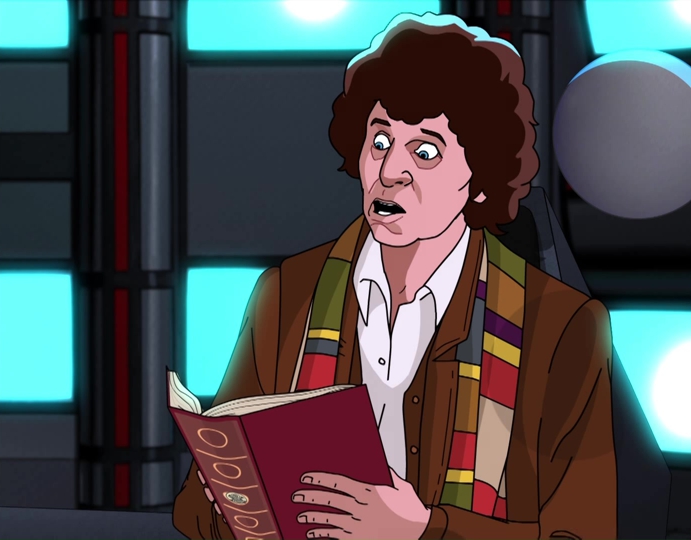
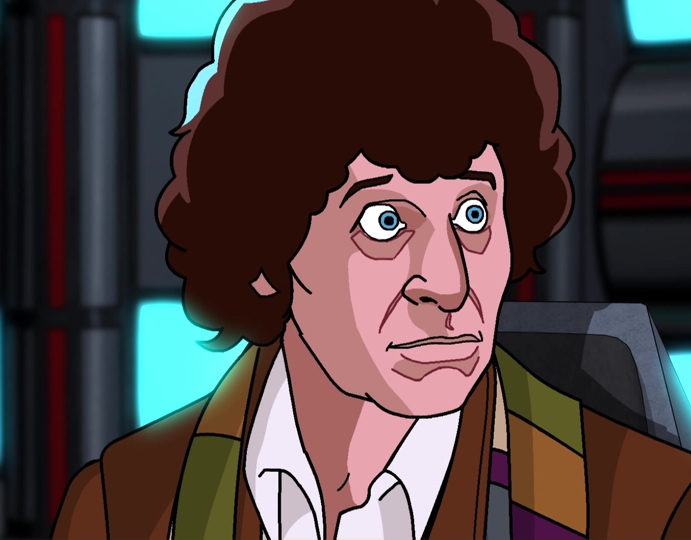
0:58:50 - The Doctor screams as the sphere attacks him
• CHARLES NORTON:
That long drawn-out gurgling scream you hear at the end of this scene is not a sound effect, nor is it electronically treated. It's an actual (and quite unsettling) noise that Tom just spontaneously decided to produce on the day. Checking my master recordings, the scream clocked in at an ear-splitting 13 seconds, with the sound peaking so high it clipped right off the top and blew all our levels.
That long drawn-out gurgling scream you hear at the end of this scene is not a sound effect, nor is it electronically treated. It's an actual (and quite unsettling) noise that Tom just spontaneously decided to produce on the day. Checking my master recordings, the scream clocked in at an ear-splitting 13 seconds, with the sound peaking so high it clipped right off the top and blew all our levels.
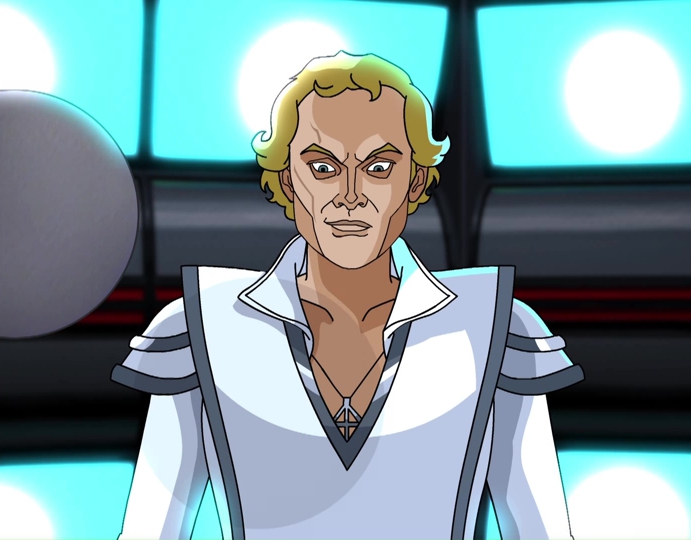
0:59:27 - Chris is meant to be delivering a lecture
• CHARLES NORTON:
The original production team managed to successfully complete shooting on this scene back in November 1979. Everything that was scripted was shot as planned. However, a few months later, their enthusiasm for the material appears to have dimmed somewhat. Notes on the 1980 four-part script of Shada indicate that they intended to delete everything in this scene from about 59'27" to 59'49". So, that's essentially all of Chris' speech about delivering his lecture.
The original production team managed to successfully complete shooting on this scene back in November 1979. Everything that was scripted was shot as planned. However, a few months later, their enthusiasm for the material appears to have dimmed somewhat. Notes on the 1980 four-part script of Shada indicate that they intended to delete everything in this scene from about 59'27" to 59'49". So, that's essentially all of Chris' speech about delivering his lecture.
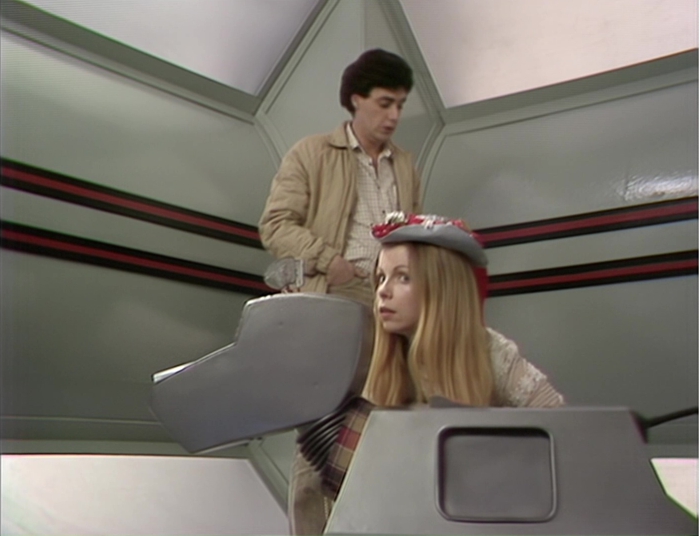
0:59:55 - K9 fires his blaster
• CHARLES NORTON:
K9's blaster effect went through a few iterations here. The original 1979 footage was naturally shot without any effects on it at all. They planned on adding it digitally onto the finished footage in post-production. Season 17 was the first season of Doctor Who to make use of digital effects in any kind of substantial way.
Of course, the production was shut down in November 1979 before any post-production effects could be completed and so we only had the clean footage to work with. Peter Crocker handled our video effects. Initially, he just put a bright red-line over the footage, as would have been done on earlier K9 stories in the 70s. However, it just didn't feel right. Rob Ritchie created a completely CGI ray, which he was also using on the animated scenes. However, this felt out of step with the 1970s video footage. In the end, we used a plain red line and Peter blurred it, so it's a bit softer at the edges. This seemed to work best.
K9's blaster effect went through a few iterations here. The original 1979 footage was naturally shot without any effects on it at all. They planned on adding it digitally onto the finished footage in post-production. Season 17 was the first season of Doctor Who to make use of digital effects in any kind of substantial way.
Of course, the production was shut down in November 1979 before any post-production effects could be completed and so we only had the clean footage to work with. Peter Crocker handled our video effects. Initially, he just put a bright red-line over the footage, as would have been done on earlier K9 stories in the 70s. However, it just didn't feel right. Rob Ritchie created a completely CGI ray, which he was also using on the animated scenes. However, this felt out of step with the 1970s video footage. In the end, we used a plain red line and Peter blurred it, so it's a bit softer at the edges. This seemed to work best.
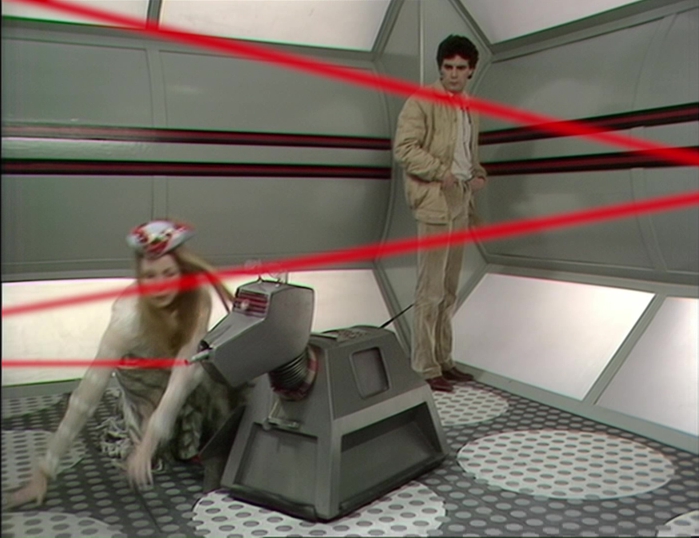
1:00:30 - Clare runs into the porter
• CHARLES NORTON:
This scene is the one that we shuffled forward from earlier, when we merged those two Skagra scenes (see 0:57:00).This sequence was originally scripted to split that last Skagra scene in two. With hindsight, I'm not sure that repositioning it here really quite works. However, there was literally nowhere else we could move it to in the narrative and still have everything make sense. It also nicely consolidates a big chunk of live-action, which was always part of the plan anyway.
Incidentally, this scene was slightly shortened for its broadcast on BBC America. The scene was trimmed down by about 14 seconds in total. This slight abbreviation lost us a small amount of Clare's exposition on the nature of the book. As before, this was to help the production fit its broadcast slot. The scene would also have been trimmed slightly had the BBC's aborted four-part transmission gone ahead in 1981. According to the plans for that edit, they'd have cut out a chunk of film from the middle of the scene.
This scene is the one that we shuffled forward from earlier, when we merged those two Skagra scenes (see 0:57:00).This sequence was originally scripted to split that last Skagra scene in two. With hindsight, I'm not sure that repositioning it here really quite works. However, there was literally nowhere else we could move it to in the narrative and still have everything make sense. It also nicely consolidates a big chunk of live-action, which was always part of the plan anyway.
Incidentally, this scene was slightly shortened for its broadcast on BBC America. The scene was trimmed down by about 14 seconds in total. This slight abbreviation lost us a small amount of Clare's exposition on the nature of the book. As before, this was to help the production fit its broadcast slot. The scene would also have been trimmed slightly had the BBC's aborted four-part transmission gone ahead in 1981. According to the plans for that edit, they'd have cut out a chunk of film from the middle of the scene.
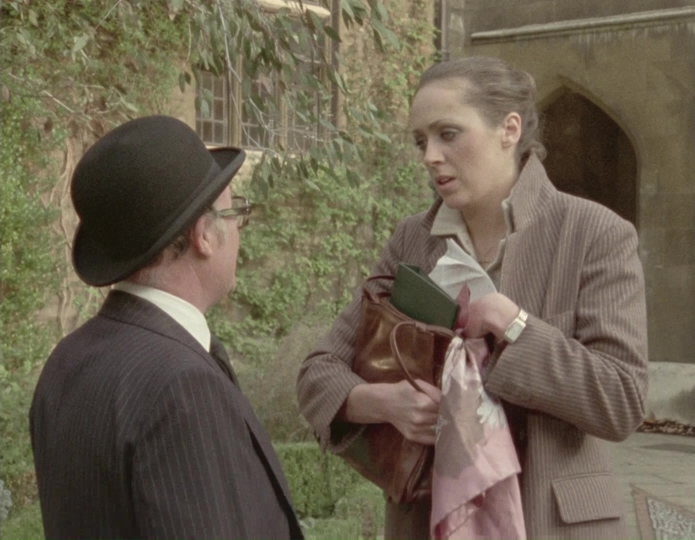
1:01:27 - The Doctor unconscious
• CHARLES NORTON:
The rehearsal script has a tiny cutaway scene at this point showing the Doctor's inert body in Skagra's ship. There's a similar one, repeating the same thing a few moments later. We moved all this material ahead in the edit and tacked it onto the front of a later scene. As usual, this was done to avoid intercutting between formats as much as practical. No material is lost in this instance, we just moved it. And besides, as there are virtually no camera notes on what might have appeared in this part of the story, we don't know how Pennant Roberts might have ended up ordering these scenes in 1979 anyway.
The rehearsal script has a tiny cutaway scene at this point showing the Doctor's inert body in Skagra's ship. There's a similar one, repeating the same thing a few moments later. We moved all this material ahead in the edit and tacked it onto the front of a later scene. As usual, this was done to avoid intercutting between formats as much as practical. No material is lost in this instance, we just moved it. And besides, as there are virtually no camera notes on what might have appeared in this part of the story, we don't know how Pennant Roberts might have ended up ordering these scenes in 1979 anyway.
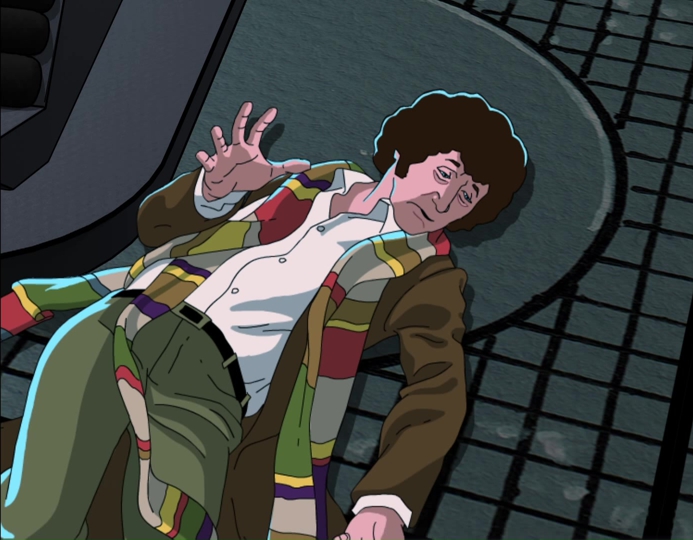
1:02:20 - Skagra doesn't march Romana down a corridor
• CHARLES NORTON:
Another diversion from the script at this point. The rehearsal script has Skagra grabbing Romana and dragging her off down a corridor. There's no indication in Pennant Roberts' unfinished camera script as to whether he intended to shoot this scene or not. We decided to leave it out on the grounds that it wasn't needed and cutting away from live action and into such a short chunk of animation at this point would have been distracting. Most of the gist of the scene is covered in the next location scene anyway. It also helped us to at least try to control how massively we were now over-running our allotted time slot.
Another diversion from the script at this point. The rehearsal script has Skagra grabbing Romana and dragging her off down a corridor. There's no indication in Pennant Roberts' unfinished camera script as to whether he intended to shoot this scene or not. We decided to leave it out on the grounds that it wasn't needed and cutting away from live action and into such a short chunk of animation at this point would have been distracting. Most of the gist of the scene is covered in the next location scene anyway. It also helped us to at least try to control how massively we were now over-running our allotted time slot.
1:02:49 - K9 and Chris are left alone in the cell
• CHARLES NORTON:
Again, this was another scene snipped out for the BBC America transmission.
Again, this was another scene snipped out for the BBC America transmission.
1:03:38 - Skagra and Romana don't walk inside the TARDIS
• CHARLES NORTON:
Another script divergence. As originally scripted, after Skagra pushes Romana into the TARDIS, we were to then leave the location film and cut to a short scene inside the TARDIS, in which Skagra tells Romana how he needs no help to pilot a TARDIS. The script would then have cut back to the location film for the TARDIS dematerialising. The missing scene would have slotted in between the penultimate and final shots of the TARDIS in the field.
I didn't want to cut to an animated scene and then back to live action for just a few seconds. So, we skipped the TARDIS interior section. This also helped give the scene a sense of urgency and pace it wouldn't have had otherwise.
Another script divergence. As originally scripted, after Skagra pushes Romana into the TARDIS, we were to then leave the location film and cut to a short scene inside the TARDIS, in which Skagra tells Romana how he needs no help to pilot a TARDIS. The script would then have cut back to the location film for the TARDIS dematerialising. The missing scene would have slotted in between the penultimate and final shots of the TARDIS in the field.
I didn't want to cut to an animated scene and then back to live action for just a few seconds. So, we skipped the TARDIS interior section. This also helped give the scene a sense of urgency and pace it wouldn't have had otherwise.
1:03:45 - Clare doesn't activate the Professor's TARDIS
• CHARLES NORTON:
Again, the scene order was slightly reshuffled here. Everything is still here, but not entirely in the order that it appears in the original scripts.
As scripted, we cut from the TARDIS leaving the field to Clare in the Professor's rooms, accidentally activating the TARDIS. The porter then opens the door and finds the void beyond. Only after all that do we rejoin the Doctor back on the ship, followed by a scene of Chris in his cell. In the final edit, we've moved the Doctor's scene on the ship, so that it now comes first. We then go to Chris in his cell and only after that do we have the material of Clare and the porter back in Cambridge.
Again, the scene order was slightly reshuffled here. Everything is still here, but not entirely in the order that it appears in the original scripts.
As scripted, we cut from the TARDIS leaving the field to Clare in the Professor's rooms, accidentally activating the TARDIS. The porter then opens the door and finds the void beyond. Only after all that do we rejoin the Doctor back on the ship, followed by a scene of Chris in his cell. In the final edit, we've moved the Doctor's scene on the ship, so that it now comes first. We then go to Chris in his cell and only after that do we have the material of Clare and the porter back in Cambridge.
1:03:45 - The Doctor wakes up on the ship
• CHARLES NORTON:
A close-up of the Doctor lying on the floor here was shortened by 12 seconds, for the BBC America broadcast.
A close-up of the Doctor lying on the floor here was shortened by 12 seconds, for the BBC America broadcast.
1:04:36 - The computer talks to the Doctor
• CHARLES NORTON:
Take a look at the background art here. It's a big close-up, so you can see it very clearly. You see how there's a sort of patterned texture to the surface of the ship's walls? That's the texture of the craft-paper onto which Graham Bleathman painted the background art. It's the weave of the paper fibre itself. You'll see it a lot throughout Shada. Especially in the second half. You'll also be able to sometimes make out the brush-strokes of his paint-brush and the ink lines around objects.
We could have digitally smoothed a lot of this out, of course. However, it was a very deliberate decision not to. We didn't want everything to look overly digital and pristine. This was a 2D animation. The characters were all originally drawn with pencils and fine ink-pens. The backgrounds and props were painted onto paper with a brush. It's done by hand and I didn't want to conceal the skill of the artists who spent a great deal of time doing some very patient work here
Take a look at the background art here. It's a big close-up, so you can see it very clearly. You see how there's a sort of patterned texture to the surface of the ship's walls? That's the texture of the craft-paper onto which Graham Bleathman painted the background art. It's the weave of the paper fibre itself. You'll see it a lot throughout Shada. Especially in the second half. You'll also be able to sometimes make out the brush-strokes of his paint-brush and the ink lines around objects.
We could have digitally smoothed a lot of this out, of course. However, it was a very deliberate decision not to. We didn't want everything to look overly digital and pristine. This was a 2D animation. The characters were all originally drawn with pencils and fine ink-pens. The backgrounds and props were painted onto paper with a brush. It's done by hand and I didn't want to conceal the skill of the artists who spent a great deal of time doing some very patient work here
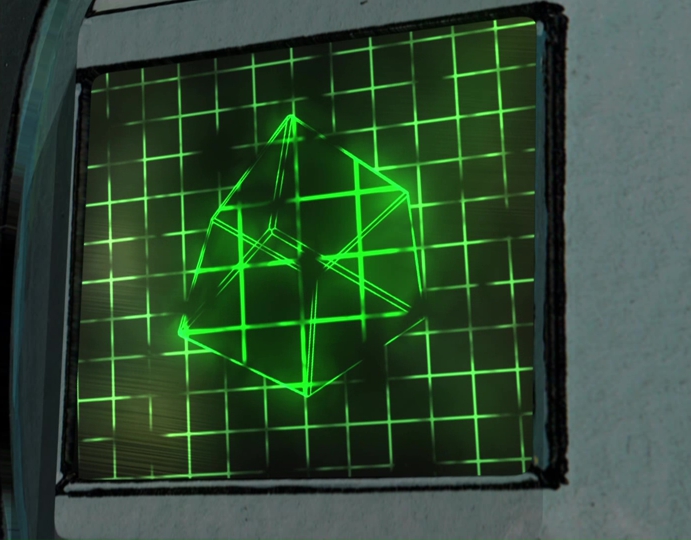
1:06:40 - The computer tells the Doctor, "Dead men do not require oxygen"
• CHARLES NORTON:
The Doctor finally slips from the bottom of frame at 1:06:43 and it is at exactly that point that BBC America cut to their next commercial break. We decided to put the ad break here, as it closely corresponds with where we think Part 3 of Shada would have ended if it had been completed as a six-part serial back in 1979. The rehearsal script has the cliff-hanger here anyway even if the camera script doesn't say anything about it one way or the other. It is also where they planned to end Part 2 of Shada had it been completed as a four-part serial for broadcast in 1981.
The Doctor finally slips from the bottom of frame at 1:06:43 and it is at exactly that point that BBC America cut to their next commercial break. We decided to put the ad break here, as it closely corresponds with where we think Part 3 of Shada would have ended if it had been completed as a six-part serial back in 1979. The rehearsal script has the cliff-hanger here anyway even if the camera script doesn't say anything about it one way or the other. It is also where they planned to end Part 2 of Shada had it been completed as a four-part serial for broadcast in 1981.
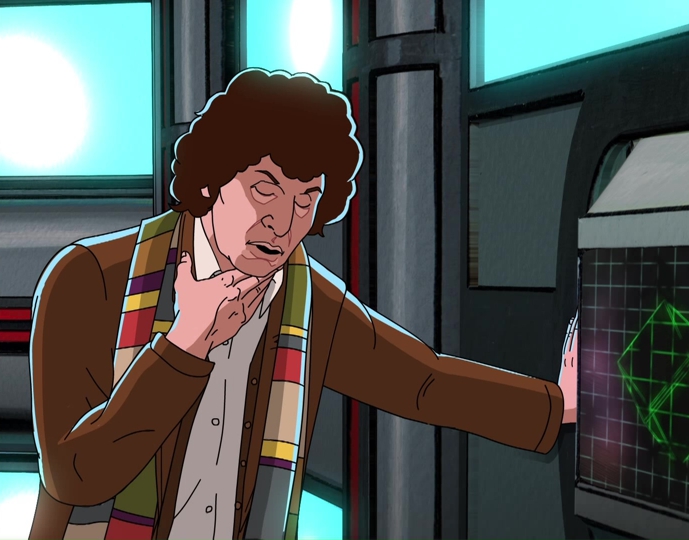
1:07:45 - Clare looks around the Professor's study
• CHARLES NORTON:
Can we just take a moment here to appreciate one very odd decision taken by the original production team in 1979, which clearly made life quite difficult for them when blocking out their shots. Look at Clare's feet here. Early on in pre-production, the wardrobe department clearly looked at the six-foot-two Victoria Burgoyne and decided to give her a pair of three-inch tall high-heels. Why is that a problem? Well most of Clare's scenes are with Professor Chronotis. And Professor Chronotis is played by Denis Carey, who is only about five foot tall. In order to make the spectacular difference in the two performers' heights less obvious to the viewer, the director has to keep coming up with interesting work-around solutions to frame his shots. Clare is frequently sat down with the Professor stood up. When they are both standing, Victoria has to remove her shoes (with the camera framing kept tight to conceal the fact). In one scene, they even go so far as getting Denis Carey to put on a hat, which they then plump up and perch high on his head, just to give him a few more inches and help balance out the framing.
There's a similar problem with Tom Baker too, of course. As Tom is roughly the same height as Victoria. In one scene, they get round this by putting Denis Carey on a step-ladder, just so he can talk to Tom in a mid-shot (which is actually a rather touching image). In later scenes containing Tom Baker, Denis Carey and Victoria Burgoyne all together in the same frame however, they generally just give up completely and there are consequently lots of shots where you can't see Denis Carey properly at all. There's no way to keep them all in frame. He's buried at the bottom of the frame somewhere or hidden by someone's elbow. In short, Costume's choice of shoes here was a really terrible idea.
Can we just take a moment here to appreciate one very odd decision taken by the original production team in 1979, which clearly made life quite difficult for them when blocking out their shots. Look at Clare's feet here. Early on in pre-production, the wardrobe department clearly looked at the six-foot-two Victoria Burgoyne and decided to give her a pair of three-inch tall high-heels. Why is that a problem? Well most of Clare's scenes are with Professor Chronotis. And Professor Chronotis is played by Denis Carey, who is only about five foot tall. In order to make the spectacular difference in the two performers' heights less obvious to the viewer, the director has to keep coming up with interesting work-around solutions to frame his shots. Clare is frequently sat down with the Professor stood up. When they are both standing, Victoria has to remove her shoes (with the camera framing kept tight to conceal the fact). In one scene, they even go so far as getting Denis Carey to put on a hat, which they then plump up and perch high on his head, just to give him a few more inches and help balance out the framing.
There's a similar problem with Tom Baker too, of course. As Tom is roughly the same height as Victoria. In one scene, they get round this by putting Denis Carey on a step-ladder, just so he can talk to Tom in a mid-shot (which is actually a rather touching image). In later scenes containing Tom Baker, Denis Carey and Victoria Burgoyne all together in the same frame however, they generally just give up completely and there are consequently lots of shots where you can't see Denis Carey properly at all. There's no way to keep them all in frame. He's buried at the bottom of the frame somewhere or hidden by someone's elbow. In short, Costume's choice of shoes here was a really terrible idea.
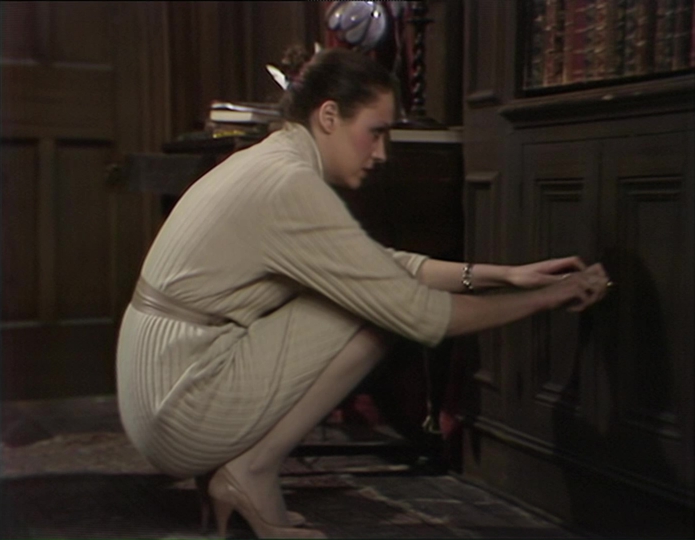
1:09:10 - The porter opens the study door
• CHARLES NORTON:
There are two versions of the vortex effect that we see here when the porter opens the door. They shot the scene twice. On the first take, they used a practical effect (involving coloured lights and tinsel) to convey the vortex pattern. On the second take, they used what appears to be a digital effect over the tinsel to achieve the same thing.
The two versions are very different. The first take is extremely of it's time. Very 70s, very disco. The second is much more obviously synthesised and digital. It looks a bit like the kind of CGI you used to get a lot on the covers of science-fiction books in the 1990s. I have no doubt that it was amazingly cutting-edge for the time. However, for the purposes of our production (which was always intended to be a bit of a celebration of 1970s Doctor Who in general), we just had to go with the disco tinsel and fairy-lights.
• MIKE TUCKER:
Dave Chapman (Electronic Effects Supervisor) used to have a ball of silver tinsel and a glittery curtain in a cupboard at the video effects workshop at Television Centre. I actually watched him put the ball of tinsel on a small turntable, stick a lamp next to it, throw the camera out of focus and shoot a minute or so of footage for use in The Greatest Show in the Galaxy in 1988, so it’s almost a certainty that this was done in a similar way.
There are two versions of the vortex effect that we see here when the porter opens the door. They shot the scene twice. On the first take, they used a practical effect (involving coloured lights and tinsel) to convey the vortex pattern. On the second take, they used what appears to be a digital effect over the tinsel to achieve the same thing.
The two versions are very different. The first take is extremely of it's time. Very 70s, very disco. The second is much more obviously synthesised and digital. It looks a bit like the kind of CGI you used to get a lot on the covers of science-fiction books in the 1990s. I have no doubt that it was amazingly cutting-edge for the time. However, for the purposes of our production (which was always intended to be a bit of a celebration of 1970s Doctor Who in general), we just had to go with the disco tinsel and fairy-lights.
• MIKE TUCKER:
Dave Chapman (Electronic Effects Supervisor) used to have a ball of silver tinsel and a glittery curtain in a cupboard at the video effects workshop at Television Centre. I actually watched him put the ball of tinsel on a small turntable, stick a lamp next to it, throw the camera out of focus and shoot a minute or so of footage for use in The Greatest Show in the Galaxy in 1988, so it’s almost a certainty that this was done in a similar way.
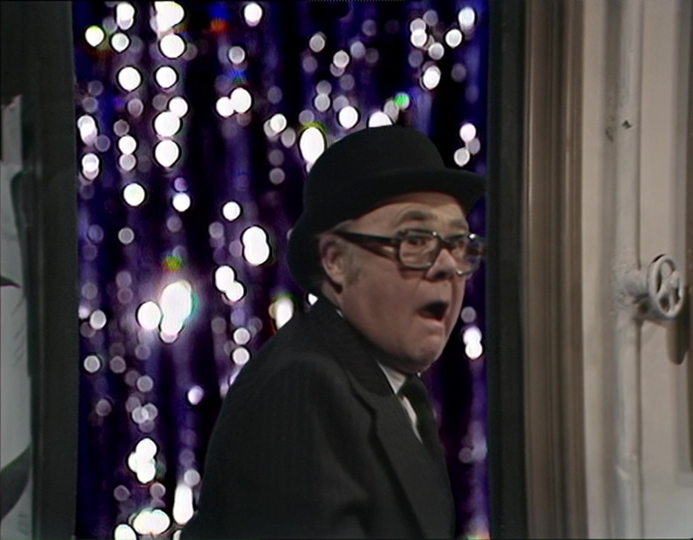
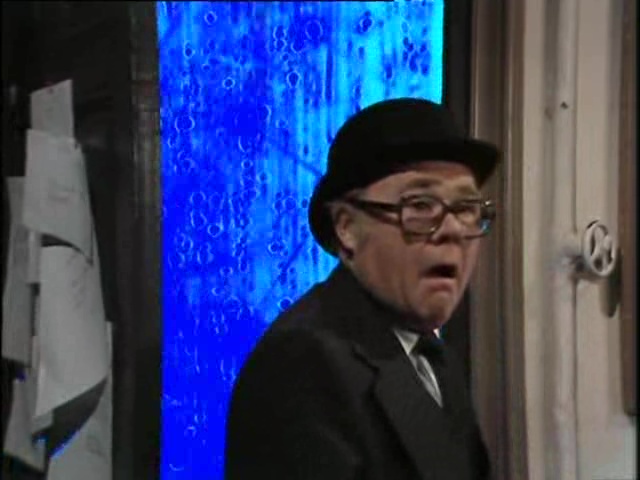
Unused Version
1:09:14 - Chris and K9 appear in the corridor and enter the flight deck
• CHARLES NORTON:
I'm inordinately fond of this little sequence. Everything just sort of worked as it was supposed to - the background, the character animation and the shading all knit together really well. Chris has shape and depth to him and his movements are fluid, helped by a motion interpolation algorithm that (for once) actually worked as it was supposed to here. K9 doesn't feel overly CG and the backgrounds all feel consistent with what you've got in the foreground. It's a section we spent more time on than we strictly needed to. And I think you can probably tell.
Chris is animated by Joanna Hepworth and K9 is animated by Rob Ritchie. The background painting is by Graham Bleathman and the shading was animated over the top by Adrian Salmon. Rob Ritchie then composited the whole thing together. There's some nice stuff a bit later on too, with some specially drawn poses of the Doctor and Chris crouching on the floor - drawn by Martin Geraghty. And also some (very complicated) colour and shading work from Adrian, with blue light spilling over the characters' faces.
I'm inordinately fond of this little sequence. Everything just sort of worked as it was supposed to - the background, the character animation and the shading all knit together really well. Chris has shape and depth to him and his movements are fluid, helped by a motion interpolation algorithm that (for once) actually worked as it was supposed to here. K9 doesn't feel overly CG and the backgrounds all feel consistent with what you've got in the foreground. It's a section we spent more time on than we strictly needed to. And I think you can probably tell.
Chris is animated by Joanna Hepworth and K9 is animated by Rob Ritchie. The background painting is by Graham Bleathman and the shading was animated over the top by Adrian Salmon. Rob Ritchie then composited the whole thing together. There's some nice stuff a bit later on too, with some specially drawn poses of the Doctor and Chris crouching on the floor - drawn by Martin Geraghty. And also some (very complicated) colour and shading work from Adrian, with blue light spilling over the characters' faces.
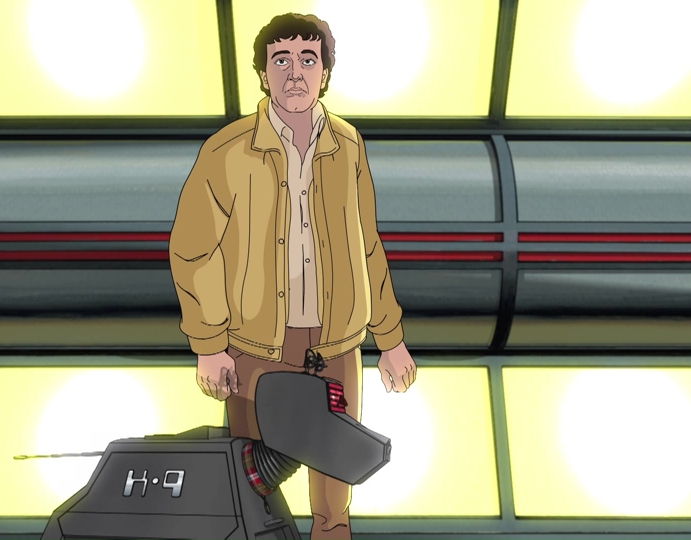
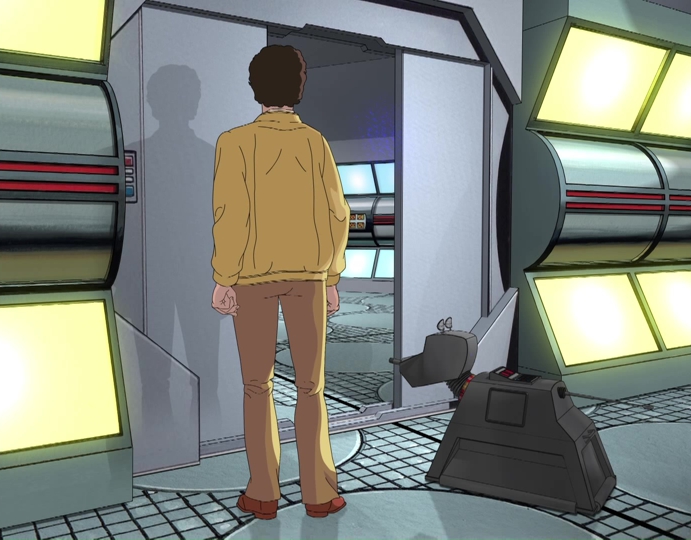
1:10:29 - K9 doesn't find the logic peculiar
• CHARLES NORTON:
Originally, after the Doctor explains his reason for being dead, K9 was scripted to say: "The logic is peculiar, but acceptable." That's what's in the 1979 rehearsal script. However, this scene wasn't recorded in 1979. And so, with David Brierley no longer with us, we were forced to cut the line from K9 and just continue the conversation between the Doctor and Chris. Happily, the removal doesn't have any obvious affect on the dialogue around it. It all still makes sense. And K9's still in the scene. He just doesn't say anything.
Originally, after the Doctor explains his reason for being dead, K9 was scripted to say: "The logic is peculiar, but acceptable." That's what's in the 1979 rehearsal script. However, this scene wasn't recorded in 1979. And so, with David Brierley no longer with us, we were forced to cut the line from K9 and just continue the conversation between the Doctor and Chris. Happily, the removal doesn't have any obvious affect on the dialogue around it. It all still makes sense. And K9's still in the scene. He just doesn't say anything.
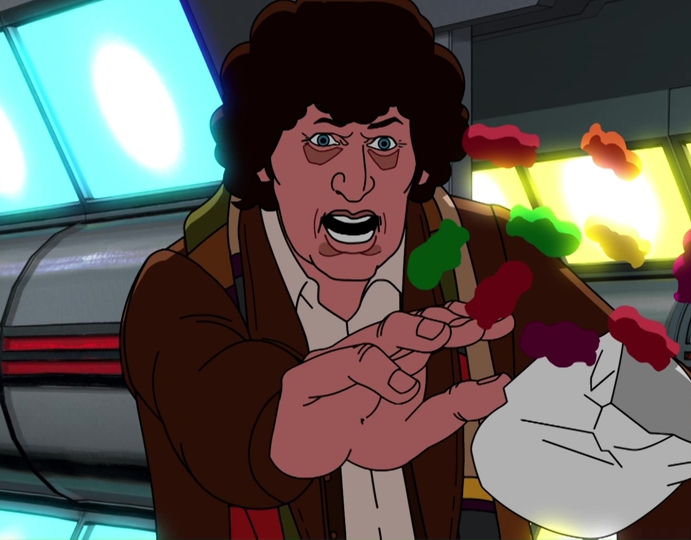
1:10:42 - The Doctor throws his Jelly Babies at the wall
• CHARLES NORTON:
A handful of the crew who worked on the animated sections of Shada weren't from the UK. As we were largely keeping in touch online, it didn't really matter if someone was animating in London or Spain or America. This led to me to a surprising realisation. Apparently, Jelly Babies are pretty much a UK-only thing. I never knew that. I'd assumed they were pretty universal. Like Coca Cola and cheeseburgers. However, the animator who worked on this shot had no idea what they were. I had to send her a photograph to work from.
There's actually two different sets of Jelly Babies in this section. You have hand drawn 2D sweets that the Doctor throws from his bag and then 3D modelled sweets that hit the wall behind Chris. The 3D sweets were done by Rob Ritchie.
A handful of the crew who worked on the animated sections of Shada weren't from the UK. As we were largely keeping in touch online, it didn't really matter if someone was animating in London or Spain or America. This led to me to a surprising realisation. Apparently, Jelly Babies are pretty much a UK-only thing. I never knew that. I'd assumed they were pretty universal. Like Coca Cola and cheeseburgers. However, the animator who worked on this shot had no idea what they were. I had to send her a photograph to work from.
There's actually two different sets of Jelly Babies in this section. You have hand drawn 2D sweets that the Doctor throws from his bag and then 3D modelled sweets that hit the wall behind Chris. The 3D sweets were done by Rob Ritchie.
1:10:46 - The TARDIS has gone
• CHARLES NORTON:
In the final edit, the Doctor asks K9 if the TARDIS is outside and K9 replies: "Negative, master." This is a slightly re-worded truncation of how this scene was originally scripted to end. In the original 1979 script, the Doctor says: "Come on, we can trace them from the TARDIS." K9 then replies: "Negative, master." To which the Doctor asks: "What do you mean?" K9 then explains: "The TARDIS has gone." Causing the Doctor to then exclaim: "Has what?" K9 then closes the scene with the line: "Gone, master."
Unfortunately, with no David Brierley to record any new dialogue for K9, we had to abbreviate the exchange using our stock K9 audio - covering in two lines what had originally been half a page.
In the final edit, the Doctor asks K9 if the TARDIS is outside and K9 replies: "Negative, master." This is a slightly re-worded truncation of how this scene was originally scripted to end. In the original 1979 script, the Doctor says: "Come on, we can trace them from the TARDIS." K9 then replies: "Negative, master." To which the Doctor asks: "What do you mean?" K9 then explains: "The TARDIS has gone." Causing the Doctor to then exclaim: "Has what?" K9 then closes the scene with the line: "Gone, master."
Unfortunately, with no David Brierley to record any new dialogue for K9, we had to abbreviate the exchange using our stock K9 audio - covering in two lines what had originally been half a page.
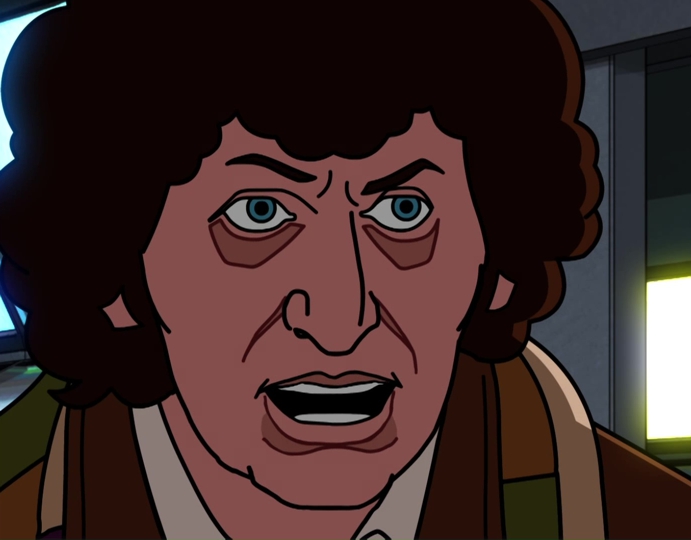
1:10:51 - Skagra and Romana don't talk about the Time Lords
• CHARLES NORTON:
Another script trim here. The rehearsal scripts and the camera scripts for both the six-part and four-part versions of the story, originally had a scene after we leave the Doctor and Chris on the ship and just before we go to the Krarg carrier. In this scene, Romana and Skagra talk about the Time Lords. However, we were over-running quite profoundly at this point and the scene didn't actually add anything to the narrative that wasn't covered elsewhere. So we omitted it.
Another script trim here. The rehearsal scripts and the camera scripts for both the six-part and four-part versions of the story, originally had a scene after we leave the Doctor and Chris on the ship and just before we go to the Krarg carrier. In this scene, Romana and Skagra talk about the Time Lords. However, we were over-running quite profoundly at this point and the scene didn't actually add anything to the narrative that wasn't covered elsewhere. So we omitted it.
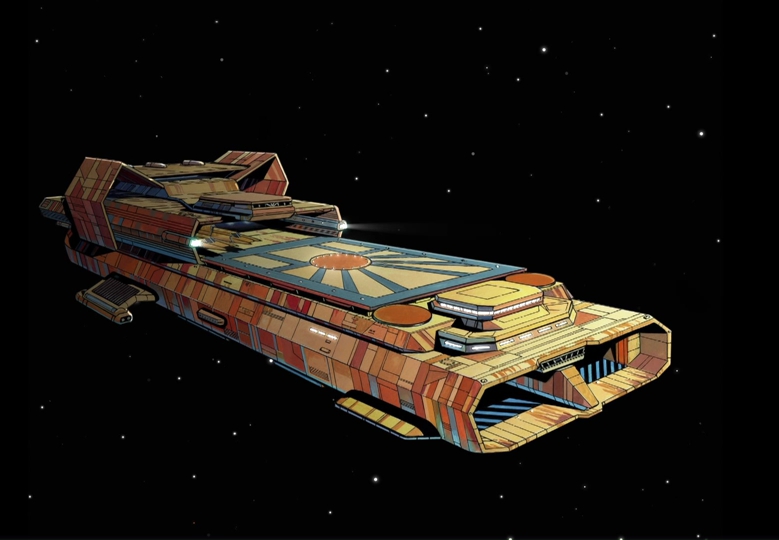
1:10:51 - The Krarg Carrier Ship
• CHARLES NORTON:
Another beautifully detailed hand-painted element from Graham Bleathman for the Krarg carrier here.
Another beautifully detailed hand-painted element from Graham Bleathman for the Krarg carrier here.
1:11:36 - A Krarg appears
• CHARLES NORTON:
As originally scripted, the Krarg would have been seen in full view here. In fact, according to Pennant Roberts' camera script, we'd have seen four Krargs, all in full-length long-shot at this point. They'd also have been seen in full view throughout the next Skagra and Romana scene. I decided to alter this. Instead, we get a point-of-view shot from the Krarg and we use that as a cliff-hanger into the next scene. I was keen to save up the big reveal of the Krarg for later on, in the generation annexe, where I felt we could build it up more and give them more impact. The more opportunities we had to tease them prior to that, the more powerful that eventual reveal would then be. That was the idea anyway.
As originally scripted, the Krarg would have been seen in full view here. In fact, according to Pennant Roberts' camera script, we'd have seen four Krargs, all in full-length long-shot at this point. They'd also have been seen in full view throughout the next Skagra and Romana scene. I decided to alter this. Instead, we get a point-of-view shot from the Krarg and we use that as a cliff-hanger into the next scene. I was keen to save up the big reveal of the Krarg for later on, in the generation annexe, where I felt we could build it up more and give them more impact. The more opportunities we had to tease them prior to that, the more powerful that eventual reveal would then be. That was the idea anyway.
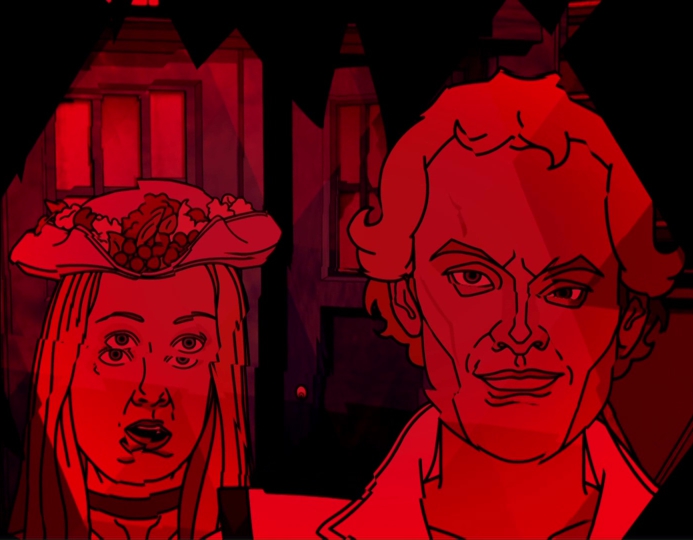
1:11:40 - The Doctor and Chris talk
• CHARLES NORTON:
This scene was another one that was lost when the edit was prepared for the BBC America broadcast in 2018. They went to a commercial break at this point, with action resuming (after the ads) with Skagra on the Krarg ship (at 1:12:29). Interestingly, this scene was also cut (in its entirety) from the script back in 1980, when the original production team were re-compiling Shada as a four-part serial.
In that script, the scenes before and after this one are merged together with no cutaway to the Doctor and Chris in between at all. We went against the final intent of the original production team here and put the scene back in, mostly just because I wanted to have some fun with the blocking of the Doctor and Chris, to be honest.
This scene was another one that was lost when the edit was prepared for the BBC America broadcast in 2018. They went to a commercial break at this point, with action resuming (after the ads) with Skagra on the Krarg ship (at 1:12:29). Interestingly, this scene was also cut (in its entirety) from the script back in 1980, when the original production team were re-compiling Shada as a four-part serial.
In that script, the scenes before and after this one are merged together with no cutaway to the Doctor and Chris in between at all. We went against the final intent of the original production team here and put the scene back in, mostly just because I wanted to have some fun with the blocking of the Doctor and Chris, to be honest.
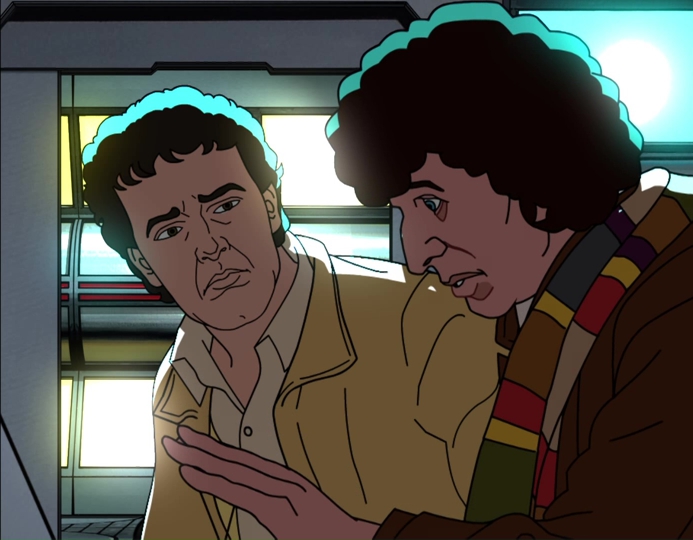
1:13:20 - Skagra and Romana talk about the nature of existence
• CHARLES NORTON:
The lighting, colouring and shading of the characters in this scene was extremely time-consuming. Adrian Salmon and David Busch started on the shading for this scene in August 2017. They did not complete the work until the first week of November 2017. The shading gets particularly involved at about the 74 minute mark. All of the shadows you see on Skagra's hands as he opens them and all of that detail on his face - none of it was there in the raw animation. It's all been animated over the top afterwards frame by frame by Adrian and David. Mind-bogglingly time-consuming.
• ADRIAN SALMON:
The scene was set on board the ship which had a predominately red environment, which encouraged me to be more subjective in lighting the shot. Skagra and Romana both required three layers each for their colouring, a background layer of realistic colour, followed by a rich blue shade layer set to ‘multiply mode’ and finally a highlight layer of crimson set to ‘lighten mode’, creating the spectacular ‘giallo effect’, as we christened it. Italian Giallo films were subjectively lit with coloured lights, instead of being realistic. This serves to heighten the drama emotionally and import mood into a scene. Imagine if Dario Argento had directed Shada - that’s the effect I wanted in the shot.
• CHARLES NORTON:
It's a lovely scene. Really well written and with a brilliant central performance from Chris. We always knew we wanted to spend some time getting it right. Indeed, we had that picture window put into the set, specifically so we could do this scene in front of it. There's no other reason for it being there.
• MARK AYRES:
This is indeed a great scene, and the only one where Charles and I had any great discussion about what the music was intended to do (for the rest is was pretty obvious). Initially I wrote a “theme” for this scene, but Charles found to too distracting. So I stripped it back and we held it very low in the mix, giving the scene real tension. It works. But nevertheless I liked my “theme” and recorded it, so it will probably be a bonus track on the eventual soundtrack album!
• CHARLES NORTON:
Incidentally, going through the original paperwork for Shada, we found that there was more than one scripted version of this scene. The scene is in both the 1979 rehearsal script (from which we mostly worked) and also the unfinished 1979 camera script. However, it is significantly cut and rearranged in the final version of the script prepared for the abandoned 1981 four-part broadcast. If you look at that last version of the script, someone has crossed out much of the material, with a thick black marker pen. Some of it is moved to later in the script, but a lot is simply deleted. I can see why the original production team did that, for reasons of pacing. However, I think it's a great shame. It's such an important scene for establishing what makes Skagra tick. Without that he's just sort of bonkers without any explanation.
The lighting, colouring and shading of the characters in this scene was extremely time-consuming. Adrian Salmon and David Busch started on the shading for this scene in August 2017. They did not complete the work until the first week of November 2017. The shading gets particularly involved at about the 74 minute mark. All of the shadows you see on Skagra's hands as he opens them and all of that detail on his face - none of it was there in the raw animation. It's all been animated over the top afterwards frame by frame by Adrian and David. Mind-bogglingly time-consuming.
• ADRIAN SALMON:
The scene was set on board the ship which had a predominately red environment, which encouraged me to be more subjective in lighting the shot. Skagra and Romana both required three layers each for their colouring, a background layer of realistic colour, followed by a rich blue shade layer set to ‘multiply mode’ and finally a highlight layer of crimson set to ‘lighten mode’, creating the spectacular ‘giallo effect’, as we christened it. Italian Giallo films were subjectively lit with coloured lights, instead of being realistic. This serves to heighten the drama emotionally and import mood into a scene. Imagine if Dario Argento had directed Shada - that’s the effect I wanted in the shot.
• CHARLES NORTON:
It's a lovely scene. Really well written and with a brilliant central performance from Chris. We always knew we wanted to spend some time getting it right. Indeed, we had that picture window put into the set, specifically so we could do this scene in front of it. There's no other reason for it being there.
• MARK AYRES:
This is indeed a great scene, and the only one where Charles and I had any great discussion about what the music was intended to do (for the rest is was pretty obvious). Initially I wrote a “theme” for this scene, but Charles found to too distracting. So I stripped it back and we held it very low in the mix, giving the scene real tension. It works. But nevertheless I liked my “theme” and recorded it, so it will probably be a bonus track on the eventual soundtrack album!
• CHARLES NORTON:
Incidentally, going through the original paperwork for Shada, we found that there was more than one scripted version of this scene. The scene is in both the 1979 rehearsal script (from which we mostly worked) and also the unfinished 1979 camera script. However, it is significantly cut and rearranged in the final version of the script prepared for the abandoned 1981 four-part broadcast. If you look at that last version of the script, someone has crossed out much of the material, with a thick black marker pen. Some of it is moved to later in the script, but a lot is simply deleted. I can see why the original production team did that, for reasons of pacing. However, I think it's a great shame. It's such an important scene for establishing what makes Skagra tick. Without that he's just sort of bonkers without any explanation.
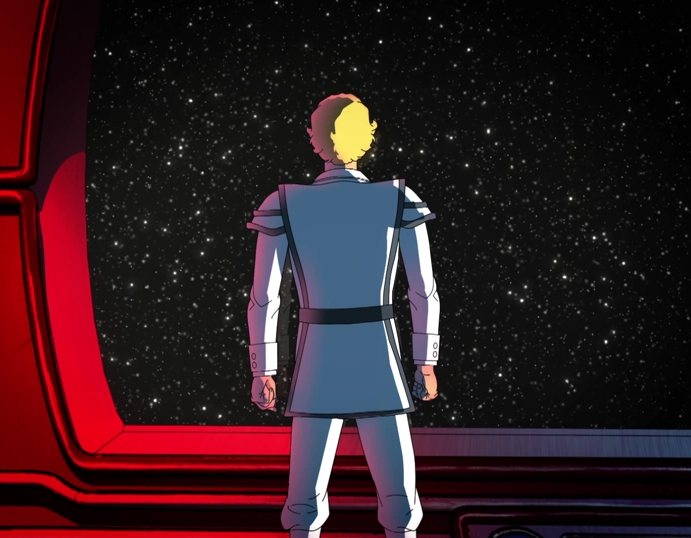
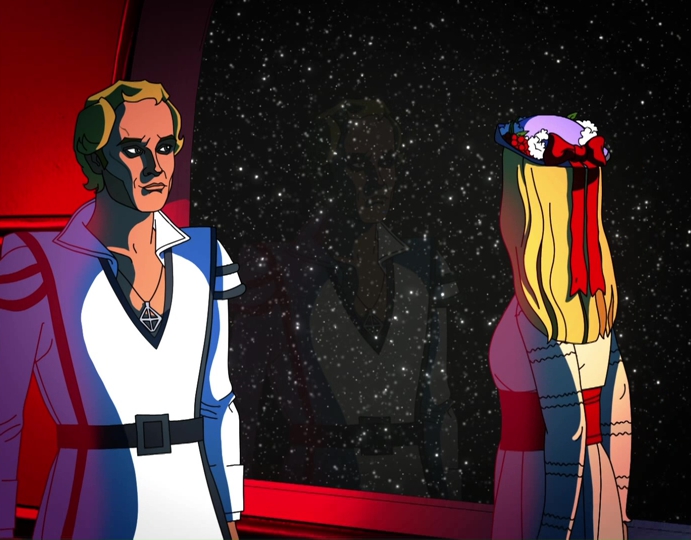
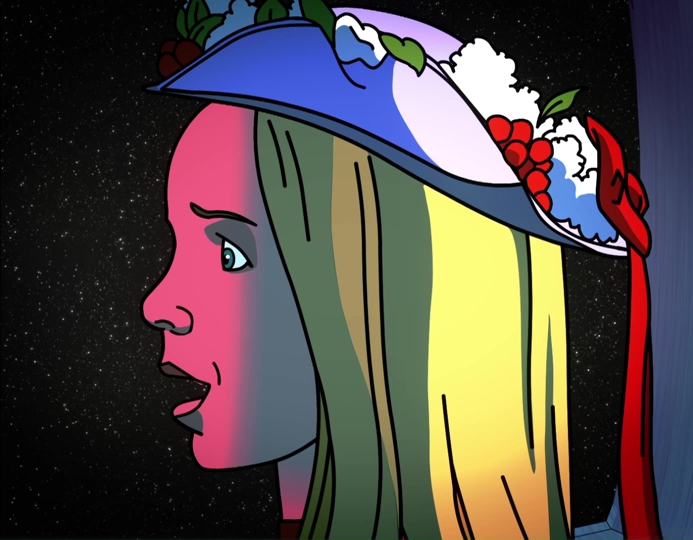
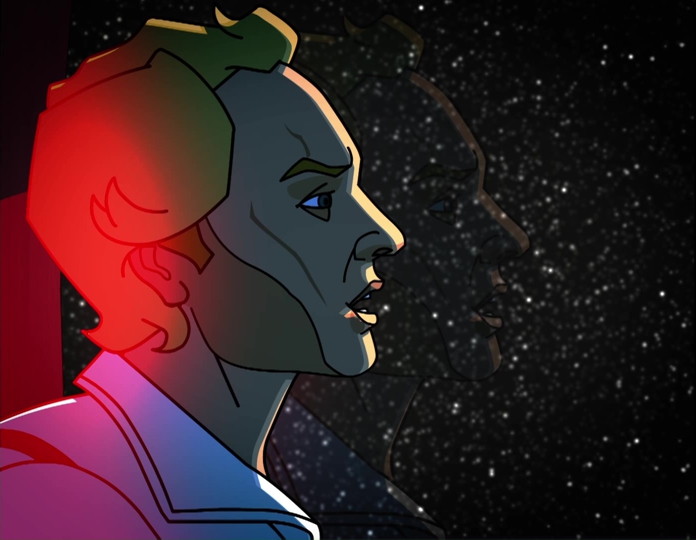
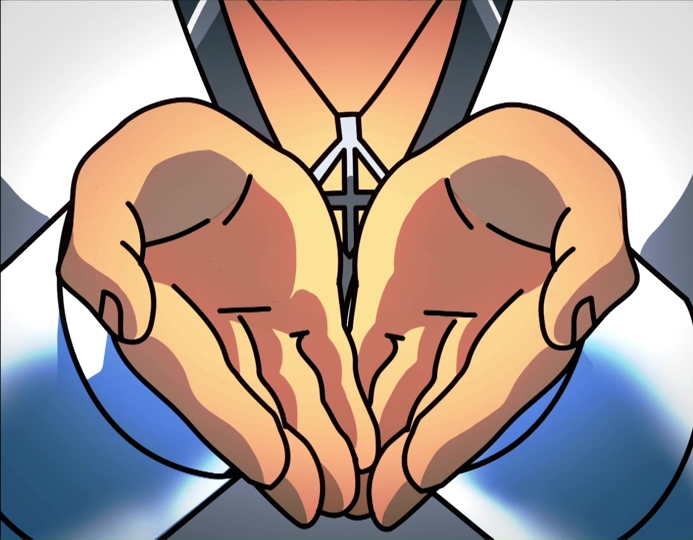
1:15:30 - The Krarg is revealed
• CHARLES NORTON:
We finally get to see a Krarg in full. We'd saved them up for as long as we could. This seemed the best moment to unveil them. They're hideously complex in animation terms. However, at least at this stage, they don't actually need to move very much, which helped. Things get a bit trickier later on, of course. They are animated throughout by Rob Ritchie.
• MARTIN GERAGHTY:
I was particularly happy at what Rob did with the Krargs, who were already one of my favourite monsters of the Williams era. I thought they looked terrific in the final animation.
We finally get to see a Krarg in full. We'd saved them up for as long as we could. This seemed the best moment to unveil them. They're hideously complex in animation terms. However, at least at this stage, they don't actually need to move very much, which helped. Things get a bit trickier later on, of course. They are animated throughout by Rob Ritchie.
• MARTIN GERAGHTY:
I was particularly happy at what Rob did with the Krargs, who were already one of my favourite monsters of the Williams era. I thought they looked terrific in the final animation.
